

From the Bonaventure to the Phoenix
Ever-changing ideas of the first warp ship - by Jörg Hillebrand and Bernd Schneider
The history of the first warp vessel, whether it was built by Zefram Cochrane himself or not, was subject to a number of revisions throughout the history of the Star Trek production. Ships with different names and different designs were labeled as the "first warp-powered vessel" or something along these lines. They are listed and investigated in the following.
In the first pilot episode, after the survivors from the SS Columbia have been found on Talos IV, Tyler tells them that "the time barrier's been broken" . We could understand this as a reference to the invention of warp drive. It would have taken place no more than 18 years before the episode, the time when the Columbia crashed on the planet (although it raises the question how the Columbia could have got there without FTL propulsion). Considering that there is solid evidence from later episodes that warp drive already existed for many decades prior to TOS, we could still argue that the "broken time barrier" refers to a breakthrough in warp propulsion not unlike the first warp flight. A breakthrough so significant that some people in the 23rd century casually call it the "invention of warp drive".
TOS: Metamorphosis
This TOS episode does not show or mention a first warp ship, but it introduces us to the inventor of warp propulsion, Zefram Cochrane. Nothing is mentioned that would imply that Cochrane himself built the first warp ship, however. We may only surmise that the first warp flight took place not too long after Cochrane's revolutionary discovery irrespective of his possible direct involvement in the building of the prototype. Since Cochrane is said to have disappeared at the age of 87 some 150 years prior to "Metamorphosis", the latest date for the launch of the first warp vessel is around 2117, because realistically he could have made his final journey into outer space only on a warp-powered ship. Since the Valiant quite obviously went to warp as soon as around 2065 according to TOS: "Where No Man Has Gone Before", the first warp prototype must have been launched a few years earlier, when Cochrane was still a young man.

Side note It is an already classic inconsistency that, according to Kirk, Cochrane used to be a denizen of the Alpha Centauri in the TOS episode, whereas "First Contact" leaves no doubt that he had never left Earth until he went of the first warp flight. Read more at Biography Inconsistencies .
TAS: The Time Trap

Regarding the age of the Bonaventure, Spock speculates that "the crew's descendants may still be living" , thereby implying that at least roughly a century has passed since her disappearance. This rules out the Bonaventure as the ship that broke the "time barrier" that was referred to in "The Cage". However, the Bonaventure could be old enough to be Cochrane's warp ship prototype, although most other evidence speaks against it.
TAS: The Counter-Clock Incident
Or does she just mean she was the "first (=chief) medical officer" on no particularly important warp ship, which would pose no problem at all? This doesn't seem so, as she puts too much emphasis on "first", and Kirk agrees with her that she used to be a pioneer in space.
Spaceflight Chronology
This book from 1980 is non-canon and was never really intended to be canon, also because it consists of just too much speculation. Aside from Rick Sternbach's co-authorship (he made the illustrations) there is one reason, however, to take the Spaceflight Chronology into account. It is the first time that the name "Bonaventure" (as a homage to TAS: "The Time Trap"), or any ship name at all, is linked to Zefram Cochrane (as a homage to TOS: "Metamorphosis"). The design depicted in the book will never show up in any canon installment of Star Trek though.

We learn in the Spaceflight Chronology that the Bonaventure was "the first ship with warp drive" and was launched in 2061. Actually, according to the book, an Earth sublight ship named UNSS Icarus made first contact with Alpha Centauri in 2048 where Zefram Cochrane, a native of the planet, discovered the principle of warp drive in 2051 (at the age of 21!). The Bonaventure is listed as a ship of the Cochrane class, which is odd, because in the tradition of Earth and Starfleet we would expect the class to be named after its lead ship, not after the inventor of its propulsion technology. There is no mention of Cochrane being involved in the development of the class aside from being its name giver.

Rick Sternbach: "I wish I had more information or memories about this particular ship, but there's not much to tell. The design was part of an evolution of early warp ships, with the lineage ultimately taking the reader up to the TOS Enterprise and the refit. The beginnings of the familiar ship elements are there, just not terribly obvious. The forward section evolved from an aerodynamic body and would later become the saucer, the body behind it would evolve into the secondary hull, and the side pods would become the warp nacelles. The big package at the aft end housed big waste heat radiators and was probably where the impulse nozzles would be located. Of course, the Phoenix seen in 'First Contact' went straight to the TOS-type nacelles, so that short-circuited any slower developmental hardware steps."
Star Trek Chronology (1st & 2nd edition)

The first edition of the Star Trek Chronology from 1993 depicts two black-and-white photos of a miniature and a color painting of Zefram Cochrane's unnamed first warp vessel. The painting can be found on the front cover. The first photo is a three-quarter front view, which adorns the introduction to the 21st century chapter with the heading "Breaking the warp barrier" . The second photo shows a side/rear view of the vessel in the entry to the year 2061, when the first warp flight was intended to have taken place. It is labeled "Zefram Cochrane's first warp-powered spacecraft" .

We can make out a registry on the painting and even a bit clearer on the front view photo. It appears to be "C1-21", which does not make sense compared to other Star Trek registries, but may simply stand for "Cochrane 1 - 21st century".
The launch date of 2061 and all depictions of this vessel were removed in the second edition of the Star Trek Chronology , issued in 1996. This adjustment was necessary because "Star Trek: First Contact" was just being produced and established different canon facts. The following notes were added to the entry of 2063: "Cochrane's ship, the Phoenix, was designed by illustrator John Eaves under the direction of production designer Herman Zimmerman. Eaves's design was based on a conjectural design for Cochrane's ship developed by modelmaker Greg Jein for the first edition of this Chronology. (Eaves made several significant changes to the design of the Phoenix, in part because the storyline for Star Trek first contact reveals that Cochrane's ship was launched from an uprated U.S. Air Force Titan missile, a fact known to Jein at the time the first Chronology was compiled.)"
DS9 episodes
The warp ship design from the Star Trek Chronology showed up in early DS9 episodes in two different forms: as the already mentioned model built by Greg Jein and as a side view depiction on a wall chart along with the then five known starships named Enterprise. More precisely we can see the early warp vessel in the following installments:
1. In DS9: "The Nagus" we can make out the wall display with the early warp ship in Keiko's classroom. There are also models of the Miranda, Nebula and Galaxy but not Jein's miniature. The classroom was previously seen in DS9: "A Man Alone" but not yet with the wall chart. 2. We can briefly see the wall chart as well as the miniature in DS9: "In the Hands of the Prophets". 3. The miniature more prominently appears in DS9: "Cardassians", but without the wall chart, although the classroom is full of other LCARS displays.
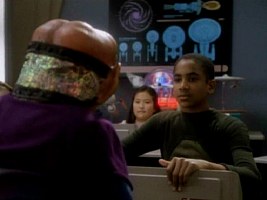
We get a good look at Greg Jein's miniature in the DVD special features to DS9's season 2, when it can be seen as a desktop decoration in Mike Okuda's office. We can clearly make out the comparably small warp engines, which are mounted on straight horizontal pylons. In contrast, the nacelles of the vessel in the Star Trek Chronology (the painting as well as the model photo) are slightly tilted down. It looks like the nacelle assembly was modified some time prior to DS9, or a second model was built as set dressing.
Mike Okuda: "Greg Jein designed the version of Cochrane's ship that was featured in the Star Trek Chronology . He did the models as a favor to us, so we pretty much gave him free reign to make what he thought was appropriate. I told him that we thought the ship would be experimental and very powerful, so he came up with that big curved radiation shield. The only change we made was to add the two rudimentary warp nacelles. We wanted it to look like something from the Matt Jefferies universe, but we wanted it to look much more primitive, and far more dangerous. Greg later made a second copy of the model, which we provided to DS9 set decorator Laura Richarz for use as set dressing. The nacelles may have been slightly different in that version, which could account for the difference in the 'dihedral.' I think the flat version was the second model. Doug Drexler loved that model and later did a quick drawing of it for use in a number of background DS9 graphics, including the one you mentioned. I'm pretty sure that those graphics were the only time that we called it 'Bonaventure,' although we did suggest that name for use in First Contact. 'Phoenix' did end up being more appropriate, given the film's story."
It also seems that in DS9: "Cardassians" the nacelles are missing, but actually they are just barely discernable because we see the ship almost straight from the side, and the nacelles are the same color as the engineering hull. If we look very closely we are able to recognize the red nacelles caps also on the episode screen cap. Hence the nacelles are still present as of the DS9 episode.

Let us have a closer look at the wall display. The big surprise is that, according to the display, this vessel is named Bonaventure. So unlike in the first edition of the Star Trek Chronology , where the design first appeared, the ship does have a name. The sub-title is "Discovery of the Space Warp" , which links the Bonaventure to Zefram Cochrane.

The wall display was made by Doug Drexler based on Greg Jein's already existing model, and prior to "First Contact". Comparing the drawing and the available screen caps of the miniature, also those from Voyager (see below), we can spot some inaccuracies in the drawing, however. Especially the rear engineering hull and the transition from this section to the aft engines is different from the model. The nacelles are located well below the centerline of the hull on the drawing, whereas they are most likely exactly on the centerline on Jein's miniature in Okuda's office. So the display is obviously based on the other version. Finally, the drawing is more colorful than the model was at any time that we know of. Our reconstructed side view schematic is based on the side view on the wall chart, but is corrected in a way to reflect the structure of the original miniature.
Doug Drexler: "Wow! I forgot about that one. That's a pretty early one for DS-9. Good times! Like so many of the graphics on the show, this one benefited by creation of the Star Trek Encyclopedia by Mike and Denise. It was a resource to them, because I'd developed so many peripheral diagrams. If a backlit came out of the blue for an episode, I could put something fun together in no time flat. Sometimes you only had a few hours to get a last minute request addressed. The Bonaventure model that Greg Jein built for Mike as made specifically for the Star Trek Chronology . See that? I automatically called it 'The Bonaventure.' The idea is that it was built by Cochrane using off the shelf garage technology. At the time that seemed far fetched... from another era... like the Wright Brothers. Could never happen again. But then Burt Rutan [who built the experimental airplane Voyager to fly around the world] came along. I'm a believer! The Phoenix grew out of this design. Early in the planning of 'First Contact,' Mike and I had done a number of illustrations showing how it would get into orbit. By the way, 'Bonaventure' was absolutely a nod to the animated show."
Star Trek: First Contact
The feature film makes it clear that Cochrane is human. Also, his ship is now named Phoenix and its design is a different one than anything shown so far, although it has many features in common with the Bonaventure that appeared on DS9. The date of the launch is now nailed down to 2063.
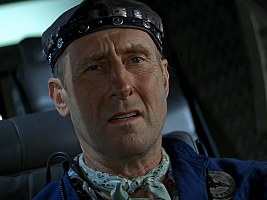
There is no way of denying or re-interpreting that Zefram Cochrane is a human being from Earth, that he constructed the first human-built warp vessel called Phoenix and launched it in 2063, as depicted in "Star Trek: First Contact". Everything that we have heard or read of other "first warp vessels" must be accordingly amended at latest in the wake of this feature film.
If TAS is canon , then the TAS Bonaventure must be ruled out as the first ship with warp drive, much less as a design by Zefram Cochrane. It has to be some other historically important vessel with a new form of warp drive and not much older than from the late 22nd century. The vessel may have been named in honor of the other canon Bonaventure, the vessel from the classroom in DS9. The design from the Spaceflight Chronology is non-canon and has been ultimately invalidated just like idea that Cochrane is indigenous to Alpha Centauri. Regarding the Star Trek Chronology , there is no notable information about a first warp ship that hasn't already been revised with regard to "Star Trek: First Contact". Ironically, the ship design that was removed from the first edition is canon nonetheless thanks to its appearance in three DS9 episodes.
The miniature and wall display from DS9 may be incorporated into the history of warp flight. Yet, we need to re-interpret the line "Discovery of the Space Warp" , knowing that Cochrane developed warp drive on Earth and made the first flight (at least the first manned one) on the Phoenix and not on a ship named Bonaventure. This leaves the option that the DS9 Bonaventure is either an unmanned testbed, or rather a vessel that was launched soon after the Phoenix and hence still contributed to the "Discovery of the Space Warp" . It is well possible that the Bonaventure was the first warp ship built for real journeys through space, as opposed to the Phoenix that served as a test vehicle for just one flight. However, even without the Bonaventure the amassment of too early and/or too advanced warp vessels poses a problem.
Finally, we may speculate that the model in VOY represents an actual early Malon vessel just like the Bonaventure is supposedly an old Earth design.
TAS Starfleet & Federation Ship Classes - including the entry about the Bonaventure
Biography Inconsistencies - gaps in biographies and other anomalies
21st Century Earth History - thoughts about early interplanetary travel, the Eugenics Wars and the Third World War
Other History Inconsistencies - about the TOS movie timeline, the UESPA, first contact with the Borg, Klingons in the Federation, etc.
Thanks a lot to Adrian of Myprops.co.uk , who is the proud owner of the Bonaventure wall chart and who authorized us to use his photographs. Thanks also to John Mesiavech, John Ritter and Zarm R'keeg for additional suggestions to resolve the Bonaventure problem. Special thanks to Doug Drexler, Mike Okuda and Rick Sternbach for their annotations!

https://www.ex-astris-scientia.org/articles/bonaventure.htm
Last modified: 25 Oct 2021

© Ex Astris Scientia 1998-2024, Legal Terms
This website is not endorsed, sponsored or affiliated with CBS Studios Inc. or the Star Trek franchise.
Fleet Yards
Screen Rant
First contact has a great star trek starship retcon.
Star Trek: First Contact shows Zephram Cochrane's first warp flight, and his ship, the Phoenix, is a retcon that explains every starship design since.
Zephram Cochrane's (James Cromwell) starship, the Phoenix, is a great Star Trek starship retcon. The Phoenix was introduced in Star Trek: First Contact as the experimental starship Cochrane built after the end of World War III. On April 5, 2063, Dr. Cochrane achieved Mankind's first successful warp flight, which caught the attention of nearby Vulcans. This led to First Contact between humans and Vulcans, the pivotal event that launched Mankind toward its optimistic future of founding Starfleet and the United Federation of Planets.
Star Trek: First Contact 's design for the Phoenix is ingenious because it literally explains the style of nearly every Starfleet ship that follows. The Phoenix launched as a cylindrical missile since Zephram Cochrane retrofitted a nuclear weapon and turned it into his starship. But after breaking free of Earth's orbit, the Phoenix's side panels opened, releasing twin nacelles before Dr. Cochrane's starship engaged into warp one. The Phoenix's twin nacelles extending was a fist-pumping moment for Star Trek fans in the audience, but it's also a brilliant retcon because it means Starfleet continued the basic twin nacelle design for most of its starships, especially its flagship, the USS Enterprise .
Related: Strange New Worlds Explains Why Humans Resent Vulcans For First Contact
First Contact Smartly Explained Star Trek's Ships Design
Along with Star Wars' Millennium Falcon, Star Trek's Starship Enterprise is the most famous spaceship in pop culture. The Enterprise's saucer section and twin nacelles, meant to resemble a bird in flight in silhouette, are iconic and instantly recognizable. But the Star Trek movies and TV series never gave an explanation as to the reason for the Enterprise's twin nacelles before Star Trek: First Contact. Thanks to the hit Star Trek: The Next Generation film, there is now an in-universe, canonical basis for Star Trek's starship design.
It's also extremely fitting that Star Trek's twin nacelles were canonically invented by Dr. Zephram Cochrane , thanks to Star Trek: First Contact 's clever retcon. After all, Dr. Cochrane is the father of warp drive, although First Contact showed the visionary as a flawed human who wallowed in alcohol and was terrified of the responsibility of being the wellspring of the future the crew of the USS Enterprise-E claimed he was. Star Trek: Enterprise later established that Cochrane influenced the construction of the NX-01 Enterprise, the first human starship with a Warp 5 engine capable of deep space exploration - and it also boasts twin nacelles.
First Contact Gave Star Trek An Origin Story
The Phoenix's iconic twin nacelles are just one part of the origin story Star Trek: First Contact gave Star Trek. While the film's intense A story was Captain Jean-Luc Picard (Patrick Stewart) fighting the Borg Queen (Alice Krige) aboard the Enterprise-E, First Contact's whimsical B story of Commander William Riker (Jonathan Frakes) and his crew ensuring Dr. Cochrane's warp flight launches on schedule is actually more important to Star Trek history. Had Riker failed, First Contact with the Vulcans never would have happened and the next thousand years of Star Trek's future would cease to be.
The Phoenix's twin nacelles launching it into warp lives on, not just in Star Trek: First Contact but also in Star Trek: Enterprise , which enshrined that moment in its opening credits set to Russell Watson's "Faith of the Heart" for all four seasons. While some Starfleet ships lack twin nacelles or have even more nacelles, they never quite look as right as the Enterprise's basic design does. Star Trek: First Contact not only gave Star Trek an origin story, but the Phoenix's retcon also smartly gave the famous look of Star Trek 's starships an origin of its own.
Next: Star Trek Confirms Picard Made The Best First Contact
Memory Beta, non-canon Star Trek Wiki
A friendly reminder regarding spoilers ! At present the expanded Trek universe is in a period of major upheaval with the continuations of Discovery and Prodigy , the advent of new eras in gaming with the Star Trek Adventures RPG , Star Trek: Infinite and Star Trek Online , as well as other post-57th Anniversary publications such as the ongoing IDW Star Trek comic and spin-off Star Trek: Defiant . Therefore, please be courteous to other users who may not be aware of current developments by using the {{ spoiler }}, {{ spoilers }} OR {{ majorspoiler }} tags when adding new information from sources less than six months old (even if it is minor info). Also, please do not include details in the summary bar when editing pages and do not anticipate making additions relating to sources not yet in release. THANK YOU
- Memory Beta articles sourced from comics
- Memory Beta articles sourced from video games
- Memory Beta articles sourced from games
- Memory Beta articles sourced from Star Trek Online
- Memory Beta articles sourced from novelizations
- Memory Beta articles sourced from novels
- View history
The Phoenix was a Human spaceship launched in 2063 . Constructed from an old Titan V nuclear ICBM , the Phoenix was designed by Zefram Cochrane , and was the first vessel in Earth history to travel at warp speed (having reached a speed of warp 1.1). The alien mineral dilithium used in the engine had been discovered on a meteorite in Antarctica . ( TNG movie : First Contact , ST reference : Federation: The First 150 Years )
The first, and only, flight of the Phoenix took place on 5 April 2063. It was launched from Montana and was crewed by Cochrane, William T. Riker and Geordi La Forge . The ship's flight attracted the attention of a passing Vulcan ship, the T'Plana-Hath , leading to first contact between Humans and Vulcans. ( TNG movie : First Contact )
- 1 Specifications
- 3.1 Connections
- 3.2 External links
Specifications [ ]
Phoenix was 20 meters long, with a 15 meter-long secondary stage that was jettisoned after launch. Its beam was 3.1 meters and draft was 3.2 meters. Its cruising velocity was warp 0.3 with a maximum velocity of warp 1.2. ( Star Trek Magazine Issue 162: "Star Trek Spaceflight Chronology")

Phoenix flight plan on 4 April 2063 .
As the singular vessel responsible for humanity's introduction to interstellar society the Phoenix is one of the most famous names in Earth and Federation history.
By the 24th century , the ship was part of the Smithsonian Institution collection and Jean-Luc Picard visited it there "hundreds of times" without physically touching the legendary vessel. ( TNG movie : First Contact )
In 2373 the Borg sent a Borg sphere back through time to the day before the launch of the Phoenix planning to destroy it, thus preventing first contact and consequently preventing humanity from developing to be a source of great resistance in the future. Fortunately the USS Enterprise -E followed the sphere back through time and destroyed it before it completed its attack. The Enterprise crew then assisted in repairs to the damaged Phoenix to permit it to launch on time. ( TNG movie : First Contact )
In 2293 , in an alternate future created when Mia Colt was transported to the future by a keepsake , Colt and James T. Kirk shared a drink in an establishment called the Phoenix Tavern , which featured a full scale replica of the Phoenix’ cockpit and upper-section which hung along the ceiling. ( EV comic : " Future Tense ")
In 2365 Kori , a child who lived in The Armada , owned a remote control model of the Phoenix . However, out of boredom, he fitted his model with explosives so that it exploded in flight. ( TNG - The Space Between comic : " Space Seeds ")
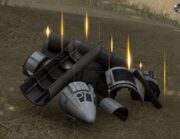
Model parts.
From 2409 onwards, Federation President Aennik Okeg invited commanding officers of the Alpha Quadrant Alliance to visit the site of the Cochrane memorial and build a model replica of the Phoenix . ( STO - Reckoning mission : " First Contact Day Re-Enactment ")
Appendices [ ]
Connections [ ], external links [ ].
- Phoenix article at Memory Alpha , the wiki for canon Star Trek .
- Phoenix article at The Star Trek Online Wiki .
- ↑ TOSC Issue 64: "Phoenix".
- ↑ 2.0 2.1 TNG movie & novelization : Star Trek: First Contact .
- 1 USS Enterprise (NCC-1701-B)
- 2 Ferengi Rules of Acquisition
- 3 USS Voyager (NCC-74656-A)

The Phoenix
- More to Explore
- Series & Movies
Published Apr 4, 2023
Origin Of First Contact Day Explained
Live long and prosper.

StarTrek.com / Rob DeHart
On the eve of First Contact Day, let's revisit the origins of this significant moment in Star Trek history.
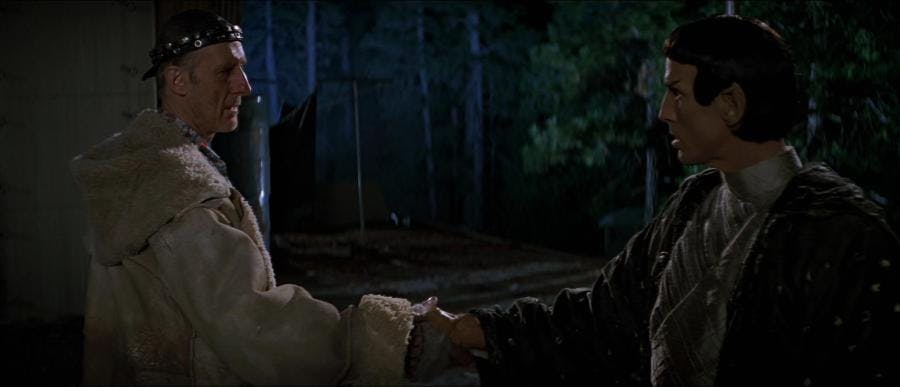
Star Trek: First Contact
StarTrek.com
How Was April 5 Chosen?
Yes, it’s time to celebrate a day that, well, hasn’t happened yet . Before we jump into a detailed explanation of what First Contact Day is within Star Trek canon, we thought we’d address a practical matter — how and why did the writers-producers of Star Trek: First Contact choose April 5 as First Contact Day?
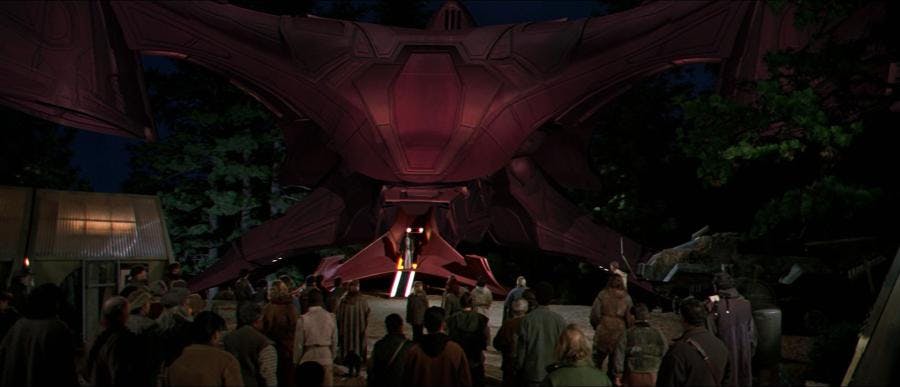
We turned to the film’s co-writer, Ronald D. Moore, who offered a remarkably simple, sensible and succinct explanation. “The short answer on First Contact Day is that it's my oldest son, Jonathan's birthday,” Moore told StarTrek.com. “And that's the only reason the date was chosen.”
What is the Significance of First Contact Day?
First Contact Day pays tribute to the flight of the warp-capable Phoenix and the pivotal first interaction between humans and Vulcans, which occurred on April 5, 2063.
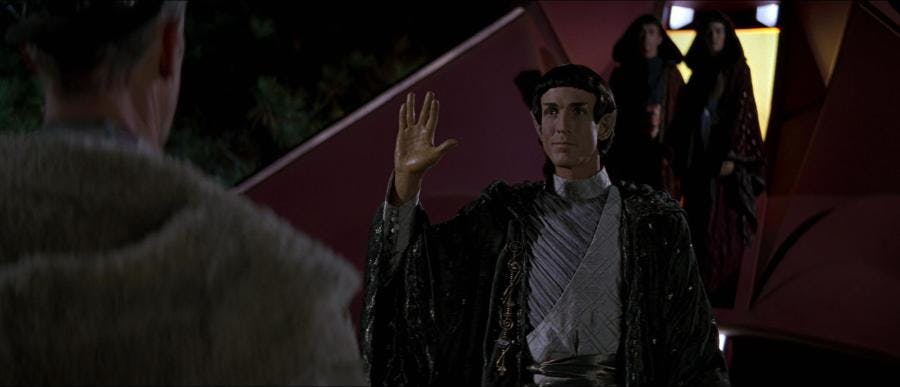
The Phoenix , built and piloted by inventor Zefram Cochrane, was the spacecraft that marked mankind’s first successful attempt at traveling at warp, utilizing a warp drive. That night, shortly after launch, the Phoenix broke the warp barrier, which caught the attention of a Vulcan survey ship, the T'Plana-Hath , as it was passing Earth.
The T'Plana-Hath , landed in Bozeman, Montana, after tracking the warp signature of the Phoenix , believing this civilization was advanced enough with their discovery of faster-than-light travel. Minutes later, a robed Vulcan, displaying the split-fingered Vulcan greeting, made the acquaintance of Dr. Cochrane, initiating Earth's first contact with another species and ushering in a new era for humanity.
First Contact was made, and it paved the way to the formation of the United Federation of Planets.
First Contact Day Watch List
Eager to discover more about First Contact and First Contact Day? We've got a watch list for you!
- " Metamorphosis " ( Star Trek : The Original Series) – Stars Glenn Corbett as a young Cochrane
- " First Contact " ( Star Trek: The Next Generation ) – Starfleet’s official definition of "making first contact" is to make contact with a planet or species that is about to become warp capable. In this episode, we see just how delicate the moment of First Contact can be.
- Star Trek: First Contact – The Next Generation big-screen adventure with James Cromwell in the role of Cochrane (which he reprises, briefly, on Star Trek: Enterprise and Star Trek: Lower Decks )
- " Homestead " ( Star Trek: Voyager ) – Neelix and Naomi Wildman throw a party celebrating the 315th anniversary of First Contact Day, complete with heaping portions of Cochrane's favorite food (cheese pierogi), a classic jukebox, and Tuvok flashing the Vulcan salute and speaking the legendary line, "Live long and prosper"
- " Grounded " ( Star Trek: Lower Decks ) – Mariner enlists her friends on a rogue mission to exonerate her mother, which includes a detour to Bozeman, Montana. In the three centuries since First Contact, Bozeman has become a tourist attraction thanks to Cochrane’s efforts. There’s even a replica of the Phoenix you can ride like a magic carpet right into space, piloted by a holographic representation of Cochrane himself!
Get Updates By Email
- Star Trek 101

The Flight of the Phoenix
The Flight of the phoenix is a grim, tenseful, realistic tale of a small group of men forced down on the North African desert and their desperate efforts to build a single-engine plane out of the wreckage of the twin job in which they crashed during a sandstorm. Robert Aldrich's filmic translation of the Elleston Trevor book is an often-fascinating and superlative piece of filmmaking highlighted by standout performances and touches that show producer-director at his best.
By Variety Staff
Variety Staff
Follow Us on Twitter
- Sweating It Out: The Best Home Saunas to Try Out The Latest Wellness Craze 1 day ago
- Cold Plunges Have Taken Over Hollywood: Here Are the Best Ones to Buy Right Now 2 days ago
- March Madness 2024: How to Watch the NCAA Tournament Online Without Cable 5 days ago
The Flight of the phoenix is a grim, tenseful, realistic tale of a small group of men forced down on the North African desert and their desperate efforts to build a single-engine plane out of the wreckage of the twin job in which they crashed during a sandstorm. Robert Aldrich’s filmic translation of the Elleston Trevor book is an often-fascinating and superlative piece of filmmaking highlighted by standout performances and touches that show producer-director at his best.
James Stewart, as the pilot of a desert oil company cargo-passenger plane who flies by the seat of his pants, is strongly cast in role and is strongly backed by entire cast. Each, seemingly hand-picked for the individual parts, are every-day persons who might either be employees of an oil company or business visitors.
A young aircraft designer, who had been visiting his brother at the oil camp, comes up with the extraordinary idea that a make-shift plane might be fashioned to fly the survivors to safety. So work starts, and it is this endeavor in its various phases that makes the story.
1965: Nominations: Best Supp. Actor (Ian Bannen), Editing
- Production: Associates & Aldrich/20th Century-Fox. Director Robert Aldrich; Producer Robert Aldrich; Screenplay Lukas Heller; Camera Joseph Biroc; Editor Michael Luciano; Music Frank DeVol; Art Director William Glasgow
- Crew: (Color) Available on VHS, DVD. Extract of a review from 1965. Running time: 149 MIN.
- With: James Stewart Richard Attenborough Peter Finch Hardy Kruger Ernest Borgnine Ian Bannen
More From Our Brands
Trump criticized after posting video depicting biden hog-tied, joseph eichler’s personal silicon valley home is up for grabs at $6.4 million, sixth street signs $500k jersey deal with sixth street-owned bay fc, the best loofahs and body scrubbers, according to dermatologists, the walking dead: the ones who live co-creators weigh in on season 2 prospects, verify it's you, please log in.
Flight of the Phoinix

Flight of the Phoinix is a zine which contains non-fiction and fiction.
This fanzine was printed on one side by mimeograph . The printing is very light purple and is difficult to read in some places.
"Phoinix" is the Greek spelling of "Phoenix."
Flight of the Phoinix v.1 n.1 was published in January 1976 and contains 31 pages. A second printing was issued in March 1976. The editor was Michael Warner who was 17 at the time of this issue's publication.
Warner states that this story was begun in 1974.
In the next issue, Warner describes how he is writing and planning a film of "Paradox in Time," in which the Star Trek elements are stripped out for ease of production and to avoid Paramount's copyright restrictions.
- From the Ashes, editorial (i)
- Paradox in Time, part 1 by Lisa Wahl and Daniel Hough (1)
- Memory Alpha Keeps on Trekkin', article by Eliot Williamson (about the history and purpose of Memory Alpha , a print zine archive created by Sharon Ferraro ) (6)
- Paradox in Time, part 2 by Lisa Wahl and Daniel Hough (9)
- ad for "The Greatest Convention in the History of Trekcons: Bi-Centennial-10 " (16)
- Spock Vs. Daneel, article by Lisa Wahl (17)
- ad for Star-Fleet Uniforms, sold by Bill Hickey (sizes were for only for men and boys) (18)
- The Society for Earth-Bound Vulcans , info about the fan club by Joy Fenton (illos by Fenton were to have appeared in this issue, but did not. They were promised for the second issue.) (19)
- Paradox in Time, part 3 by Lisa Wahl and Daniel Hough (23)
- To Feather Our Nest, about the zine submissions (29)
Reactions and Reviews: Issue 1
This first issue contains commentary by Lisa Wahl on the character of Spock v. the character of Issac Asimov's android, R. Daneel. The rebuttal of Asimov's erroneous conclusion that Spock and Daneel were both popular because of the their similar philosophies was concise and logically-executed, but could have benefitted from more explanation of who Daneel was, so that the arguments could be more readily understood. 'Phoinix' also has an interesting informational ad on Memory Alpha -- its function, duties, and how to submit fanzines for immortality. Anyone who still doesn't know about this ST fanzine archive should contact Sharon Ferraro . The main body of the zine is composed of a three-part novel by Lisa Wahl and Daniel Hough called 'Paradox in Time,' which is concerned with a 20th century woman who invented warp drive fifty years before Zephram Cochran even thought about it. Dr. Corina Larson's one-person ship pulls through a black hole, and is displaced to the Enterprise future, where the doctor creates the paradox mentioned in the title: even though she has the proper communications and enough power, she cannot return to the past, because her existence in the Enterprise's past would alter the Federation present. Although this time-paradox plot has been used unsuccessfully many times in past fanfic, 'Paradox' is definitely worth reading, due to excellent characterizations and several twists in the story. Corina Larson is one of the few intelligent women I've met in fan fiction who does not fall in love with Kirk or Spock (or McCoy, or...). She is dedicated to her scientific studies yet has a warm, human nature and stands alone as a strong character. Unfortunately, some of her strength of will is attributed to Janice Lester -type psychosis. Although the depictions of the regular crew are cursory at best, we are allowed to see a very rare angle of Kirk's personality at the conclusion of the novel. I have only technical criticisms of the zine, although I'm sure the editor has already spotted them: print a table of contents! Also, simpler type-setting would be appreciated because twenty-plus pages of script can become quite tiresome. The advertisements in 'Phoinix,' while very interesting, could be a little more strategically placed, so they do not interfere with the continuity of the fiction. All in all, a good first attempt. The artwork scheduled for the first issue was delayed, and will appear in the next 'Phoinix,' for which editor Mike Warner is now soliciting material. Suggested fiction and artwork topics are: time travel, sf in movies or on television and J.R.R. Tolkien . [1]
Got FOTP today and read it through before evening. I'm impressed by the writing, particularly the reviews ("Paradox in Time" was a good story, but since it was the only fiction in the zine I can't make much judgement on FOTP's literary quality yet). Altogether a surprisingly good 1st issue, Congratulations. [2]
[Asimov]: Greetings, Had I said Mr. Spook was exactly like R. Daneel, Ms. Wahl would have been right to become huffy. However, all I said was that Spock and Daneel were alike "in some ways," which is true. [Asimov]: I appose Ms. Wahl is right in saying that Spock isn't utterly unemotional, and I suppose that she has fantasies of breaking him down. Being a heterosexual male, I don't have those fantasies, so I am willing to let it be " utterly ." [Warner]: (In the interest of fair play, and, hopefully, to the readership, Lisa Wahl's response to the above statements have included immediately following.) [Wahl]: First of all, I was not attempting to be huffy. I realise that the Good Doctor did say that Spock and Daneel were alike only in some ways," but he certainly implied that the reasons Spock and Daneel were attractive to women were the same in both cases. That is what I believe to be untrue. [Wahl]: Now, as to "fantasies of breaking him (Spock) down" the Good Doctor seems to be basing his judgement of all female Spock fans on the reactions of his daughter, Robyn. Perhaps I'm equally narrow-minded by using my feelings as a basis for my observations, but I try not to assume that any one person reacts to Spock as my one test-case does. As Jacqueline Lichtenberg noted , all fans seem to be seeing a different Spock. If I have "fantasies of breaking him down," they are so deeply buried in my subconscious that I am not aware of them. In fact, I consciously reject the typical Spock stories that appear in so many fanzines. [Wahl]: The way I see Spock, he is not imperturbable, but I'll get to that in a moment. He could be reached, "broken down," but the process of change would be enormously painful. No one who really cared about him would want mt to cause such a thing. Perhaps if he did learn to cope with his human half instead of suppressing it he would be happier, but part of him would be lost. He would be a weaker person, and his regard for himself would go down considerably. He certainly would not be the Spock we all know and love. [Wahl]: But, back to the "utterly unemotional" statement. I'd like to hear Dr. Asimov explain Spock's actions in "The Menagerie" on the basis of logic. Does he really think that Spock's smile in " Amok Time " was "utterly unemotional"? Can he really believe that Spock's well-known compassion is the result of logic alone? To see an unemotional Spock, we need only to look at " Mirror, Mirror ." There is an unemotional Spock, devoid not only of emotion, but also of compassion. [Asimov]: (As for my daughter's reactions to Spock. That was when she was 12. Since then she has reacted favorably to a number of real people, I believe. -- IA) [3]
I met Lisa Wahl at the NY Star Trek Con this month, and she sold me a copy of FOTP. I enjoyed it VERY much. Not many zines publish the variety of fiction and information found in FOTP. It's also good to see a ST zine interested in SF . Thanks for the praise. Although PHOINIX is not intended to be strictly a ST zine. It was created to deal with all Realms of the Imagination. Hope you enjoy future issues. - MW [4]
Enjoyed #1 greatly, especially "Paradox in Time." It was very well written and well constructed. Also enjoyed the articles, including "Spock Versus Daneel" as I also enjoy straight SF and would like to see more of this type of article. [5]

Flight of the Phoinix v.1 n.2 was published in September 1976 and contains 12 pages. The editor was Michael Warner who was 17 at the time of this issue's publication.
In the editorial, the editor talks about a film he is planning to create:
Plans regarding the making of a film based on the story "Paradox in Time"(see last issue) have begun Lisa Wahl, the author, has given consent and is very enthusiastic about the project (who wouldn't be?). The project will be headed by yours truly, and will enlist the aid of Memory Alpha II and various other institutions in the Tri Lakes area of Upper New York. Designs for sets and ships have begun to take shape on my drawing board and I am taking a close look at the story in order to begin work on the screenplay (will be approved by Lisa, of course). The film will take place on a new class of Starship (Discovery class science and research vehicle), and will have a new set of characters. These changes are being made because of copyrights (held by Paramount), and for the sake of freedom in set design (to cut down on overhead) and special effects. If any of you are musically inclined, or know anyone who is, and would like to help us out; we need music written for the song "Time is My Friend"(from "Paradox in Time"). If you are interested, please contact me as soon as possible.
- From the Ashes: Future Flights and Sights, editorial (1)
- Beside the Golden Door, fiction by Michael Warner ("Who will remember us when we're gone?") (original science fiction) (2)
- "Young Editor Publishes What He Wants to Read," news article by Helen Ward, reprinted from "Adirondack Daily Enterprise, February 10, 1976 - topic is Michael Warner, the editor of this zine. The topic is the meaning and purpose of science fiction literature and how it has evolved from the early days where "bug-eyed monsters" and "mad-doctors" of the past gave it a bad name.)
- Crabapple Luck by David Fox ("A tale of knights, fair maidens, and misadventure in the days of yore.") (original science fiction) (5)
- Random Elements, article by Bruce K. Bradley ("Through a mirror brightly - a look at alternate worlds in science fiction." - discussed "Man in the High Castle," "Mid-Summer Tempest," and the Amber Series .) (7)
- Vulcan Architecture by Joy Fenton ("These illustrations were omitted from #1, and are presented here as promised.") (Star Trek: TOS) (8)
- The House of Future-Past by Michael Warner ("There are none so blind...") (original science fiction) (9)
- poem by Blackwolf (Star Trek: TOS) (10)
- To Feather Our Nest, letters from Patrice Cullen , Leslie Fish , Issac Asimov , and Lisa Wahl (10)
- Readership Poll (12)

from v.1 n.2

Reactions and Reviews: Issue 3
I found your magazine (#2) to be very entertaining and creative, especially the two stories you did. I think you have a very strong descriptive style of writing. You stimulate the reader's imaginative faculty, and you motivated the esoteric side of me. [6]
I'm not sure what I should say about FOTP since I am known to be a very hard critic. [...] Since I got a free copy, the price was just right. I think that, unless you are paying your contributors, or unless some attention is given seriously to [the method and style of printing], the price is high. Overall, it would be difficult to make a judgement without understanding just what your aspirations are with respect to the circulation of your publication; that is, just how many of which people you are hoping to reach. Two ways, out of many, of looking at the situation are these: publish what you personally like and let the magazine find its readers; or, know who you want for readers and publish what they would enjoy finding. The trouble with the first way is that it is often a discouragement to find how few are those who are enthusiastic about exactly the same things we ourselves are. The trouble with the second is it always seems a pander. The solution may be to dress up what we personally want to heat in a style that others find attractive. There are many difficult questions raised here with which I am unprepared to deal with at the moment. [7]
Flight of the Phoinix v.1 n.3 was published in May 1977 and contains 17 pages.

From the editorial:
In the last issue, I announced plans for a Star Trek based movie called "Paradox in Time." This project has been shelved for the time being, due to the lack of interest and enthusiasm on the part of many of those who originally planned to take part in it. This movie may yet be made sometime in the future. I must apologize for my ignorance in regards to "Time is My Friend" already being a song. Lisa Wahl, author of the story "Paradox in Time," sent me a copy of the original music, and thereby cleared up the matter for me. Thanx Lisa.
Speaking of computers, I came across an item that I thought might be of interest to the readership. The following is from a recent article in CHRSITIAN LIVE magazine: "Dr. Hendrick Eldeman, chief analyst for the Common Market Confederacy, announced recently that a computerized restoration plan is already underway in Brussels, according to the ALTOONA MZBHOB (Pa) The Beast is a gigantic computer that takes up three floors at the Administration Building of Market headquarters. This self-programming unit has over 100 sensing in/out sources. Computer experts have been working on a plan to computerize all world trade. This master plan involves a digital numbering system for every human on Earth for buying and selling. The number would be invisibly 'laser-tattooed' on the forehead or the back of the hand and would show up under an infra-red scanner to be placed at all check-out counters and places of business. Dr. Eldeman suggested that by using three sets six digital units, the entire world could be assigned a working credit card number. Credit notes would be exchanged through a World Bank Clearing Center." It is interesting to note that the above system was prophesied almost 2,000 years ago by John. In the Book of Revelations, chapter 13 verses 16-10, it states: "And he shall causeth all, both small and great, rich and poor, free and bound, to receive a mark on their right hand or foreheads: And that no man might buy or sell, save that he had the mark, or the name of the beast, or the number of his name." Are these the last days? Think on it.
One of the poems:
There once was a Vulcan named Spock Whose hobby it was things to grok . "Human beings," he said, "Are a pain in the head." "Grokking them's a very great shock." -- M. Warner
- From the Ashes, editorial by Michael Warner (1)
- The Future of Star Trekkin', article by Sylvia Hunt ("Star Trek will never die because its spirit is undying. Sylvia Hung takes a look at what makes Star Trek tick.") (3)
- Encounter in an Empty Place, fiction by Mike Warner ("A second encounter with Cantos, the storyteller of Thave.") (original science fiction) (6)
- Shadows of the Allegorical in the Lord of the Rings, article by Eric Holz ("A brief look at symbolism and allegory in Tolkien's masterwork of fantasy.") (Lord of the Rings) (8)
- poetry by Marilyn Pehr and Michael Warner (both original science fiction and Star Trek: TOS) (15)
- To Feather Our Nest, letters of comment (16)

from v.1 n.3, Padre (illo of Frankenstein)

from v.1 n.3, Padre (illo of Dracula)
I am writing this note because I just received your Phoinix #3 and I wanted to applaud you efforts. Unlike a few of your readers, I contend that your zine is improving in quality with every issue. After reading your "Encounter in An Empty Place" I would like to see a longer piece in this same vein. Our two zines's both view SF from different perspectives, and hopefully are enjoyed by all. Again, much success with Phoinix. May it fly to fans forever! [8]
Flight of the Phoinix v.2 n.1 was published in June 1978. It contains six articles and is 20 pages long. This was the last issue to be published.

From the editor's farewell:
It is almost a year and a half now since I put out the first issue of this zine. Since that time there have been many changes in my life, and, necessarily, in the "feel" of PHOINIX. And now, I must say farewell to you all, for with this issue PHOINEX ends its short life. What I have done in the past has been a rewarding experience, but I just can't do it by myself any more. I hope that the past three issues have been of some interest to you, and that this issue will be equally interesting. Being chief-cook-and-bottle- washer for this project is not quite so easy now (it never really was) that I am involved with so many other exciting things... One being my novel {a fantasy), which I hope to complete and release by the end on the year, be on the look-out for it, O.K. In fact, as a little added attraction, I have included at the end of this mess, a little foretaste of what my book is about.
- Excerpts from a Review of Tolkien's " The Silmarillion " -- The Price of Fantasies by Richard Adams (1)
- Arthur, Logres, and the Search for Security: A Reflection on the Dream, essay by John Roberts (5)
- "Griffin, art " by S. Carter (7)
- "Et Tu Brute?, " essay by Joadie Lilley (8)
- "Phoenix, art " by John Collins (9)
- Beyond the Walls of the World: The Nature and Value of Fantasy, essay by Michael Warner (10)
- To Feather Our Nest, One Last Plume, a letter of comment (16)
- Ashes to Ashes: A Farewell to All by Michael Warner (the editor bids farewell and an end to this zine, plus an excerpt from a fantasy book Warner is hoping to publish: "What I have done in the past has been a rewarding experience, but I just can't do it by myself any more. I hope that the past three issues have been of some interest to you, and that this issue will be equally interesting. Being chief-cook-and-bottle-washer for this project is not quite so easy now (it never really was) that I am involved with so many other exciting things.") (16)
- ^ from The Halkan Council #16
- ^ from a letter of comment by Leslie Fish in the second issue
- ^ from a letter of comment by Issac Asimov in the second issue
- ^ from a letter of comment by Patrice Cullen in the second issue
- ^ from a letter of comment in the third issue
- ^ from Anthony Targonski, editor of Droid & Tribble
- Non-fiction Zines
- Star Trek TOS Zines
- Star Trek TOS Non-fiction Zines
- 1970s Zines
Navigation menu
- Cast & crew
- User reviews
Flight of the Phoenix

Survivors of a plane crash in the Mongolian desert work together to build a new plane. Survivors of a plane crash in the Mongolian desert work together to build a new plane. Survivors of a plane crash in the Mongolian desert work together to build a new plane.
- Lukas Heller
- Scott Frank
- Edward Burns
- Dennis Quaid
- Miranda Otto
- Giovanni Ribisi
- 243 User reviews
- 120 Critic reviews
- 47 Metascore
- 2 nominations

- Frank Towns

- (as Kirk Jones)

- See all cast & crew
- Lukas Heller (1965 screenplay)
- Production, box office & more at IMDbPro
More like this

Did you know
- Trivia The model used for the crash sequence cost $250,000 and was so perfectly built it actually flew further than the crew and testing had predicted. In fact it flew so far it hit the camera filming it and broke the cameraman's leg.
- Goofs The nomads have dromedary camels which are native to Arabia whereas the Bactrian camel is native to the Gobi desert.
Sammi : I thought you weren't religious, Rady?
Rady : Spirituality is not religion. Religion divides people. Belief in something unites them.
- Connections Featured in Profile: Hardy Krüger (1978)
- Soundtracks I've Been Everywhere Written by Geoff Mack Performed by Johnny Cash Courtesy of American Recordings, LLC Under license from Universal Music Enterprises
User reviews 243
- Dec 14, 2005
- How long is Flight of the Phoenix? Powered by Alexa
- Can you build a new aircraft out of a wrecked one?
- Is it really possible to build a new plane out of an old one?
- December 17, 2004 (United States)
- United States
- Phượng Hoàng Cất Cánh
- Namib Desert, Namibia
- Twentieth Century Fox
- Aldrich Group
- Davis Entertainment
- See more company credits at IMDbPro
- $45,000,000 (estimated)
- $21,009,180
- Dec 19, 2004
- $35,021,497
Technical specs
- Runtime 1 hour 53 minutes
Related news
Contribute to this page.

- See more gaps
- Learn more about contributing
More to explore

Recently viewed

Zefram Cochrane
- View history
Dr. Zefram Cochrane was a Human scientist in the 21st century and a pivotal figure in Human history . An eccentric genius , he was the inventor of warp drive on Earth and became the first recorded Human to travel faster than light , prompting official first contact with the Vulcans . ( Star Trek: First Contact ; ENT : " Broken Bow ", " Future Tense ", " Home "; TOS : " Metamorphosis "; TNG : " New Ground "; VOY : " Threshold ", " Friendship One ")
- 1.1 Early life
- 1.2 Developing warp drive
- 1.3 Later life
- 2.1 Lily Sloane
- 2.3 Deanna Troi
- 2.4 Henry Archer
- 2.5 Nancy Hedford
- 3 Personality
- 4 Memorable quotes
- 5.1 Appearances
- 5.2.1 Performers
- 5.2.2 Introduction
- 5.2.3.1 Rewriting the character
- 5.2.3.2 Recasting the role
- 5.2.3.3 Costuming for movie
- 5.2.3.4 Second portrayal
- 5.2.4 Later references and appearances
- 5.2.5.1 Theories
- 5.2.6 Trivia
- 5.3 Apocrypha
- 5.4 External links
Biography [ ]
Early life [ ].
Cochrane was born in the 2030s . ( TOS : " Metamorphosis "; ENT : " In a Mirror, Darkly, Part II " library computer file ) His place of birth was Montana , North America , Earth. ( ENT : " Shuttlepod One ")
Cochrane's circumstances were somewhat affected by World War III , gaining him at least minimal knowledge of ECON , one of the aggressors in that conflict . ( Star Trek: First Contact )
Developing warp drive [ ]
During the 2060s , Cochrane and his team of engineers began developing the warp drive . ( Star Trek: First Contact ) The challenge of inventing warp theory took Cochrane an extremely long time. ( ENT : " Anomaly (ENT) ") In 2061 , he was responsible for Earth's first successful demonstration of light speed propulsion, though his work was far from complete. ( VOY : " Friendship One "; ENT : " In a Mirror, Darkly, Part II " library computer file ) His primary motivation for commencing warp technology was financial gain in the devastated, poverty-stricken America that existed in the wake of the Third World War.
He finally built Earth's first warp ship , the Phoenix , in the hope its success would prove profitable and allow him to retire to a tropical island filled with naked women. A historical irony was that, contrary to the fact he went on to use the Phoenix to inaugurate an era of peace, Cochrane incorporated a weapon of mass destruction into its design; he constructed the Phoenix in a silo on a missile complex and used a Titan II missile as his launch vehicle.
By 4 April 2063 , Doctor Cochrane had made plans to pilot the Phoenix on a test warp flight that was scheduled to launch the next morning. That night, he was witness to an attack from a Borg sphere that fired on the missile complex from above; Borg photon torpedoes exploded extremely close to him, as he desperately struggled to escape. Cochrane was thereafter sought by the crew of the Federation starship USS Enterprise -E , who had recently come back in time from the year 2373 to stop the Borg sphere from preventing first contact. He was temporarily considered by the Enterprise crew to have been killed in the Borg attack.
By the time Dr. Cochrane was located by the Enterprise crew, he had abandoned hope for the continuation of the Phoenix , wishing that the prototype craft would "rest in peace." Cochrane was convinced to half-heartedly persist in his endeavors by the Enterprise -E crew, who treated him like a historical figure, which he was to them. When they confronted him with some particulars of his future image as herald of a better world, Cochrane refused to accept this new role. He initially attempted to literally flee from his destiny, pretending that his departure was merely temporary so he could urinate . He was subsequently pursued by a squad of officers and shot down with a phaser – which he thought of as a laser – set to a minimal power output and wielded by an impatient Commander Will Riker .

Zefram Cochrane on his historic warp flight with Riker and La Forge
Cochrane then became more cooperative; by 10:00 a.m. on 5 April, he had mentally prepared himself to make history (despite a distinctly uncomfortable hangover ) and had begun readying the Phoenix for liftoff, even though he still disputed the notion of being idolized. An hour later he was aboard the Phoenix as it launched, with Commander Riker and Lieutenant Commander Geordi La Forge accompanying him. Cochrane was not only instrumental in the flight of the Phoenix – at one point giving the instruction to activate warp drive with the command, " Engage " – but was also amazed to view the Earth and the Enterprise -E from space and was shocked to experience the sensation of traveling at warp. He broke the warp barrier just after 11:00 a.m., enough to draw the attention of the T'Plana-Hath , a type of Vulcan survey ship which was passing near Earth.

Cochrane making first contact with a Vulcan
That evening, Cochrane was among many Human spectators who watched the Vulcan ship land in Bozeman, Montana, thereby making first contact with Humans and opening a new era for the whole of mankind. Finding difficulty in returning a Vulcan salute , he welcomed the arrival of the ship's Vulcan captain by engaging him in a handshake, for which Cochrane was thankful. ( Star Trek: First Contact )
In an alternate timeline , the Borg succeeded in stopping Cochrane from breaking the warp barrier. His failure to execute that achievement eventually resulted in Earth's being inhabited by an entirely Borg population of approximately nine billion. ( VOY : " Relativity "; Star Trek: First Contact )
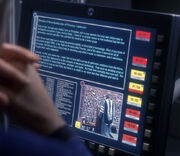
A quote and image of Cochrane presenting his commencement address at Princeton
In 2064 , Cochrane acknowledged details about the first contact in Bozeman, in a commencement address at Princeton University . He claimed it had involved "a group of cybernetic creatures from the future" which had been repelled by a group of Humans who had come from the same era. However, Cochrane's remarks were largely shrugged off by his audience as a result of his tendency toward imaginative stories and intoxication. ( ENT : " Regeneration ")
In time, Cochrane resigned himself to the role history had apparently written for him, rather than maintaining the more fantastical truth of what had happened. ( Star Trek: First Contact ; ENT : " Regeneration ") He recanted his own statements regarding first contact and the two warring groups involved in the event a few years after making the claims. ( ENT : " Regeneration ") In 2073 he was recorded as proclaiming, " Don't try to be a great man; just be a man, and let history make its own judgments. " ( Star Trek: First Contact )
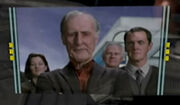
Zefram Cochrane in 2119, with Henry Archer to his left
In the early 22nd century , Cochrane designed a style of warp reactor that was fitted aboard J-class freighters . It was rumored that he personally signed the inside of each reactor casing. ( ENT : " Horizon ") He also collaborated with Henry Archer on the warp five engine around this time, working hard to develop it and help make it a reality. In 2119 , Cochrane officially opened the Warp Five Complex on Earth, making a speech at the opening ceremony. ( ENT : " Broken Bow ") Cochrane met Henry's son, Jonathan Archer , the future captain of Enterprise NX-01 , while the elder Archer was giving his son a tour of the facility. ( ENT : " Singularity ", " Daedalus ") In a historic holoprogram , Cochrane was said to have given Henry Archer a bottle of whiskey in celebration on the day they broke ground at the Warp Five Complex. ( ENT : " These Are the Voyages... ")
Later life [ ]
At the age of eighty-seven, Cochrane left his new home on Alpha Centauri colony for an interstellar expedition. ( TOS : " Metamorphosis "; ENT : " In a Mirror, Darkly, Part II " library computer file ) In a state of tiredness and dying from old age, he chose to die in space. ( TOS : " Metamorphosis ") His body was never recovered and he was presumed dead. ( TOS : " Metamorphosis "; ENT : " Future Tense ", " In a Mirror, Darkly, Part II " library computer file )
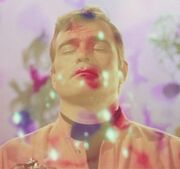
Cochrane communicates with the Companion
Cochrane ended up on an asteroid in the Gamma Canaris region . He was brought there, while in a disabled spaceship and virtually dead from old age, by a cloud -like entity which he called the Companion . Cochrane was rejuvenated by this entity, which went on to keep him young and alive for 150 years. At one point he cannibalized his ship, using left-over tools and supplies to construct a building where he could live. Necessities including food and water were provided for him by the Companion, with whom he could telepathically communicate . However, Cochrane eventually wished to be released from the entity's supervision, finding immortality boring. In an attempt to obtain freedom from the Companion he explained that he was lonely, so it decided to bring him other Humans for company.
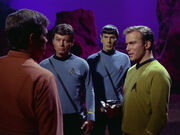
Cochrane greeting Kirk, Spock, and McCoy in 2267
In 2267 , Captain James T. Kirk , Commander Spock , and Dr. Leonard McCoy of the USS Enterprise were ferrying Federation Commissioner Nancy Hedford , who was terminally ill , aboard the shuttlecraft Galileo when they were mysteriously brought to the asteroid by the Companion. Cochrane was delighted to meet the newcomers there, exchanging handshakes with each of the other men, and was impressed by the configuration of their shuttlecraft . Nevertheless, he originally kept the truth from the visitors, saying he had crashed on the asteroid an indeterminate time ago and feigning ignorance of the Companion. Under duress from Kirk, he conceded the facts, such as confessing the actual specifics of his arrival. Cochrane repeatedly talked with the Starfleet officers about the differences in the galaxy since his disappearance, remaining tempted to leave the asteroid. The Federation and universal translator were both new concepts to Cochrane. His knowledge of modern propulsion was also updated thanks to Spock and Kirk, the latter of whom observed that Cochrane didn't "look a day over thirty-five."
Faced with the quandary of either escaping the Companion and helping Commissioner Hedford to a hospital or risking the death of the Companion, Cochrane reluctantly opted to endanger the entity, despite being exceedingly grateful for its guardianship; this choice led to his being struck down and momentarily rendered unconscious. In a conversation that Kirk had with the entity, the Companion repeatedly called Cochrane "the man". Once it was discovered that the Companion was actually feminine with romantic feelings toward Cochrane and the female entity entered the body of Hedford, Cochrane was finally allowed to leave with his guests, though the merged entity was unable to accompany him. Feeling greatly indebted to the Companion for having rescued and cared for him, Cochrane began a new life on the asteroid with the newly integrated being, both of them now with a typical Human life span . Cochrane had Kirk swear never to reveal his fate to the authorities. ( TOS : " Metamorphosis ")
Though Zefram Cochrane (at the time of First Contact) did not have a grand vision of ushering in a new era for mankind or of endowing Earth with the gift of warp technology, these qualities came to be commonly ascribed to him by later generations ; as with many of history's icons, the man's legend was less multifaceted than he himself had been. ( Star Trek: First Contact )
Abundant hearsay circulated in the aftermath of Cochrane's disappearance. One supposition was that he had been testing an experimental warp ship. He was also reputed to have been flying a one-man craft at the time he was lost. ( ENT : " Future Tense ") Another rumor regarding Cochrane was that he had personally signed the inside of each reactor casing aboard the series of J-class freighters. ( ENT : " Horizon ")
Numerous phrases that Cochrane had used in the speech he gave at the dedication ceremony for the Warp Five Complex were repeated by Starfleet for generations to come, such as talk of exploring "strange new worlds," seeking out "new life and new civilizations ," and going boldly "where no man has gone before." ( ENT : " Broken Bow ", et al.) The latter line in particular later adorned the dedication plaques of various starships named Enterprise (albeit somewhat paraphrased, as " ...to boldly go where no man has gone before " or " ...to boldly go where no one has gone before "), for centuries to come. ( Star Trek: Enterprise ; Star Trek: The Original Series ; Star Trek: The Next Generation ; Star Trek films set artwork) In 2151 , a recording of the speech was displayed at the launch ceremony for Enterprise , Jonathan Archer's command. At the same ceremony, the showing of the recording was prefaced by Admiral Forrest giving a speech of his own in which he repeatedly alluded to Cochrane, describing his warp flight as "legendary". ( ENT : " Broken Bow ")
A statuette of Cochrane was kept by Captain Archer in his quarters aboard Enterprise during that vessel's time in service. ( ENT : " Broken Bow ", " Fortunate Son ", et al.)
While teasing American Starfleet officer Charles Tucker III about his nationality in November 2151, Lieutenant Malcolm Reed posited that, if Cochrane had been European rather than from Montana, the Vulcans would have been far less reluctant to help the Humans progress with space travel than they ultimately had been. Reed also reckoned that, as an American, Cochrane likely spent his boyhood nights reading about cowboys and Native American Indians. ( ENT : " Shuttlepod One ")
After Tucker and Captain Archer became inadvertently entangled in a symbiotic lifeform , Tucker rhetorically asked Archer whether, by speaking about new life and new civilizations, Cochrane had meant aliens such as the one that was currently trapping them. ( ENT : " Vox Sola ")
By 2152 , Cochrane's involvement in First Contact was well known among school children and a statue of him had been built in Bozeman. ( ENT : " Carbon Creek ") In 2152, Cochrane still had surviving family and Admiral Forrest characterized his disappearance as "the greatest missing person case of the century." When Enterprise came across a mysterious craft adrift in space in October , 2152, manned by one dead occupant , Captain Archer wondered if it could be the long-lost Cochrane. In the interest of determining the deceased pilot 's identity, Dr. Phlox submitted a request to the Cochrane family for them to release Cochrane's genetic profile . However, it was soon learned that the pilot was a Human from the 31st century whose Earth vessel had suffered a critical disaster, in which he had been killed, while visiting the 22nd century. ( ENT : " Future Tense ")
By 2153 , the Cochrane Equation had been named in Zefram Cochrane's honor ; it described a fundamental mathematical expression in warp theory. ( ENT : " Anomaly (ENT) ") Cochrane distortion , a fluctuation in the subspace field that all warp engines generate, also took its name from him. ( TNG : " Ménage à Troi ") A unit of measure of subspace distortion known as the cochrane was named in his honor too. ( TNG : " Journey's End ", et al.) The Cochrane deceleration , a well-known battle maneuver in the 23rd century , was also named in his honor. ( TOS : " Whom Gods Destroy ") The first chapter of Basic Warp Design , a required course in Starfleet Academy 's curriculum , was titled "Zefram Cochrane". ( Star Trek: First Contact )
Numerous schools were named after Cochrane by 2154 . ( ENT : " Home ") One academic institution was called Zefram Cochrane High School ( Star Trek: First Contact ) and a scientific research organization was called the Zefram Cochrane Science Institute . ( SNW : " A Quality of Mercy ") In 2154, Hernandez guessed that these schools were fewer than those named after Jonathan Archer following the Xindi incident , which Hernandez estimated were two or three dozen in North America alone. ( ENT : " Home ") In 2267 , Spock remarked that Zefram Cochrane's name was "revered throughout the known galaxy," but Cochrane himself considered spending the remainder of his life with the feminine combination of the Companion and Nancy Hedford to be "honors enough." By that point, planets, great universities , and cities had been named after him. ( TOS : " Metamorphosis ") A starship bearing his name, the USS Cochrane , was launched in or by 2367 . ( TNG : " The Drumhead "; DS9 : " Emissary ", et al.)
In a holodeck program set in 2161 , Hoshi Sato noted that Archer's avoiding credit for the Coalition of Planets would be similar to Cochrane's taking no credit for warp drive. It was also this holoprogram that cited Cochrane as having given a whiskey bottle to Henry Archer, a recollection mentioned by the holographic Jonathan Archer. ( ENT : " These Are the Voyages... ")
In 2256 , Captain Gabriel Lorca of the USS Discovery cited Cochrane, along with Orville and Wilbur Wright and Elon Musk to get Lieutenant Paul Stamets to continue his work on the spore drive and asked if he wanted his own name to stand alongside those other inventors or if he wanted to go down in history as a failed scientist. ( DIS : " The Butcher's Knife Cares Not for the Lamb's Cry ")
In 2368 , an excited Geordi La Forge voiced an expectation that participating in one of the first tests in soliton wave propulsion would be akin to witnessing Cochrane engage the first warp drive. ( TNG : " New Ground ") This is ironic considering that La Forge went on to do precisely that. ( Star Trek: First Contact )
When the command staff of the USS Voyager was contemplating whether to allow Tom Paris to venture on a test flight of transwarp drive in 2372 , Captain Janeway remarked that, if the flight was successful, Paris would join an elite group of historic pilots whose names already included Cochrane's. ( VOY : " Threshold ") Two of Voyager 's complement of shuttlecraft were eventually named Cochrane : the original shuttle , and its replacement . ( DS9 : " Emissary "; VOY : " Threshold ", " Day of Honor ", " The Raven ")
Zefram Cochrane was so memorable that – when quizzed by Harry Kim , during the Year of Hell version of 2374 , about the name of the famous ship that had been involved in making Earth's first contact with Vulcans in Montana – B'Elanna Torres could remember only that it had been Cochrane's vessel. ( VOY : " Year of Hell ")
By 2375 , a Starfleet award called the Cochrane Medal of Honor was named to commemorate Cochrane. ( VOY : " Timeless ") In an alternate timeline, a similar award with the same namesake was the Cochrane Medal of Excellence . ( VOY : " Non Sequitur ")
In 2378 , the crew of Voyager paid respects to Cochrane, celebrating the 315th anniversary of First Contact by throwing a party on the traditional holiday of First Contact Day ; in the ship's mess hall , rock and roll music was played from a jukebox and cheese pierogi were served, since they had been Cochrane's favorite music and food respectively. ( VOY : " Homestead ")
In the early 2380s , the Phoenix replicas of the Ride the Phoenix attraction at the Historical Bozeman theme park , developed surrounding the site of Cochrane's statue, featured a hologram of Cochrane that piloted the ships on a recreation of his First Contact Day flight. Visitors could also get a souvenir replica of Cochrane's cap. ( LD : " Grounded ")
Relationships [ ]
Lily sloane [ ].
One of Cochrane's good friends was Lily Sloane , whom he had known since the Third World War. She nicknamed him "Z". ( Star Trek: First Contact )
He was also on first-name terms with several residents of Bozeman, including a bartender called Eddy .
Deanna Troi [ ]

Cochrane toasting with Deanna Troi, watched by Will Riker
Cochrane was physically attracted to Deanna Troi for a brief time after first meeting her, though he had difficulty remembering her first name. He made several sexual advances on her, though these were spurned, Troi drunkenly concluding he was "nuts". Even with these rejections, he was not disheartened to the extent that he stopped socializing with her – at one point voicing satisfaction to learn Riker was not her husband – and Troi was later among Cochrane's collaborators during the test flight of the Phoenix , as she announced the final countdown before liftoff from outside the craft. ( Star Trek: First Contact )
Henry Archer [ ]
During their time working together, Cochrane would gift Henry Archer a special bottle of whiskey the day they broke ground at the Warp Five Complex . Archer would later give that bottle to his son Jonathan Archer . ( ENT : " These Are the Voyages... ")
Nancy Hedford [ ]
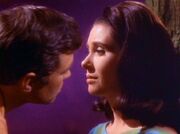
Zefram Cochrane approaches the merged female entity, just before kissing her
Similarly, Cochrane immediately found Nancy Hedford attractive, referring to her as "beautiful." Thinking of the Companion as a lover initially disgusted Cochrane, however, and he at first found the binding of Hedford and the Companion to be frightening . Realizing that his intolerance of the alien's feelings for him was motivated by prejudice , he ultimately fell in love with the female combination, even sacrificing the opportunity to explore the galaxy so he could stay with her. One final confession that he offered to Kirk was that his love for her – convinced they would have many happy years together – was the motivating factor for his staying on the asteroid, rather than simply gratitude to the entity. ( TOS : " Metamorphosis ")
Personality [ ]
Often wearing civilian clothing that incorporated a thin neck - scarf and a backwards cap on his head , Cochrane had a cynical streak. For example, he skeptically questioned Lily Sloane's theorizing that the attacking Borg sphere was an ECON craft, and he took considerable persuading before he finally came to realize the truth about the Borg and the officers from the Enterprise -E. ( Star Trek: First Contact )
Cochrane also had an alcohol abuse problem. He commonly drank whiskey but was also known to imbibe shots of tequila . ( Star Trek: First Contact ) The inventor of the transporter , Emory Erickson , adopted Cochrane's practice of celebrating scientific breakthroughs by consuming large amounts of alcohol and once recalled of Cochrane, " Now there was a man who knew the benefits of a little liquid courage. " ( ENT : " Daedalus ")

Cochrane with his telescope
Cochrane was well acquainted with the stars in Earth's proximity, owning a telescope and being able to identify the constellation Leo on sight. ( Star Trek: First Contact ) His favorite food was cheese pierogi. ( VOY : " Homestead ") He had an intense dislike for air - and space-travel and preferred taking trains .
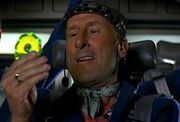
Cochrane handling a recording of one of his favorite songs
Cochrane was a fan of late- 20th century rock and roll music. His favorite songs included " Ooby Dooby " by Roy Orbison and " Magic Carpet Ride " by Steppenwolf . He often became stressed if he couldn't listen to recordings of such music when he wanted to, and introducing the Vulcans to rock and roll was one of his first priorities during their encounter. ( Star Trek: First Contact )
Cochrane was also somewhat interested in agriculture . In his initial deception of the Starfleet officers who visited him on the asteroid where he eventually resided, he alleged that he grew vegetables in fields near his house. Cochrane later admitted that the Companion provided gardens for him, and, moments before his visitors from Starfleet departed, he supported his determination to remain on the asteroid by saying its surface conditions were optimal for growing things and by suggesting that he might try planting a fig tree . ( TOS : " Metamorphosis ")
After Lily Sloane advised him that he would regret drinking alcohol to the point of having a hangover while piloting the Phoenix on its maiden voyage into space, Cochrane claimed to her that he never had regrets. This was not entirely true, however. ( Star Trek: First Contact ) For instance, he regretted his early prejudice regarding the Companion's love for him. ( TOS : " Metamorphosis ")
Memorable quotes [ ]
" Who is this jerk? (slurring) And who told him he could turn off my music? "
" And you people, you're all astronauts on... some kind of star trek? "
" You people got some pretty funny ideas about me! You all look at me as if I'm some kind of... saint , or visionary or something! " " I don't think you're a saint, Doc. But you did have a vision. And now we're sitting in it. " " You wanna know what my vision is? Dollar signs, money! I didn't build this ship to usher in a new era for Humanity. You think I wanna go to the stars? I don't even like to fly! I take trains! I built this ship so I could retire to some tropical island... filled with naked women. That's Zefram Cochrane. That's his vision. This other guy you keep talking about, this historical figure? I never met him. I can't imagine I ever will. "
" Someone once said, 'Don't try to be a great man. Just be a man, and let history make its own judgments. " " That's rhetorical nonsense. Who said that? " " You did. Ten years from now. "
" Let's rock'n'roll! "
"Sweet Jesus !"
" Live long and prosper. " " Thanks. "
" On this site, a powerful engine will be built. An engine that will someday help us to travel a hundred times faster than we can today. Imagine it – thousands of inhabited planets at our fingertips ... and we'll be able to explore those strange new worlds, and seek out new life and new civilizations. This engine will let us go boldly... where no man has gone before. "
" You're food to a starving man. "
" I could even offer you a hot bath . " " How perceptive of you to notice that I needed one. "
" Immortality consists largely of boredom. "
" What was it they used to call it? The Judas goat ? "
" I can't leave her. I love her. Is that surprising? " " Not coming from a Human being. You are, after all, essentially irrational. "
Appendices [ ]
Appearances [ ].
- TOS : " Metamorphosis "
- Star Trek: First Contact
- " Broken Bow "
- " Regeneration " (photo)
- LD : " Grounded " (hologram)
Background information [ ]
Performers [ ].
In " Metamorphosis ", Zefram Cochrane was played by Glenn Corbett . Veteran actor James Cromwell portrayed the character in the film Star Trek: First Contact and Star Trek: Enterprise pilot episode " Broken Bow ". For the latter appearance, he received no credit.
Introduction [ ]
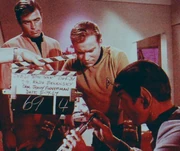
The filming of a scene involving Cochrane
In both the first draft and the revised final draft of the script for "Metamorphosis", Cochrane was described thus: " He is a young, sturdy, tall, handsome man in his mid-thirties, dressed in a one piece set of coveralls. " In the first draft of the "Metamorphosis" teleplay, Cochrane encountered not only Kirk, Spock, and McCoy, but also Montgomery Scott , who was delighted to meet the noted inventor and discuss some engineering with him. ( The Star Trek Compendium , UK 4th ed., p. 71) Cochrane also reacted much more frustratedly to the revelation of the Companion's female gender and love for him than he does in the episode's final version; enraged, he called the Companion an emotional vampire , repeatedly yelled, "Nasty," raved and screamed, threw rocks , grabbed a club , and even tried to physically attack her. The conclusion to the same draft of the script involved Spock wondering – in the company of the three other Enterprise crewmen – if the fact that Nancy and the Companion shared the same body might result in Cochrane's being a bigamist, an idea Kirk dismissed as nonsense. [1]
Cochrane's introduction in the final version of "Metamorphosis" was partly filmed with a fish-eye camera lens, though its use at first caused him to appear strange. " When Cochrane entered the foreground and ran toward the group at the [shuttle]craft, it seemed as if he had on seven league boots; he was covering what seemed like a football field distance in about five paces, " explained the episode's director, Ralph Senensky . " I solved this by filming his approach from several angles, which were then joined together in the editing room. " [2]

Film re-creation [ ]
Rewriting the character [ ].
The decision to include Zefram Cochrane in the film Star Trek: First Contact was preceded by the movie's writers choosing to set the story at a time when they could also feature Humans and Vulcans making first contact with one another. " Lo and behold, we looked around and found Zefram Cochrane sitting around the same time period, " recollected co-writer Ronald D. Moore . ( Captains' Logs Supplemental - The Unauthorized Guide to the New Trek Voyages , p. 171) Rick Berman , who worked on the film as producer and story co-writer, concurred, " We realized where our story was going and that we could marry those elements [Cochrane and Humanity's first warp flights] into the story. " ( Cinefantastique , Vol. 28, No. 6, p. 21)
How to depict Cochrane in the movie was a subject of much debate among the writers, including Ronald D. Moore, who later recalled, " We had very long discussions about who Cochrane was and who he should be in this film. And what we decided was you wanted to see a transition. You wanna see an arc for the character. " ( audio commentary , Star Trek: First Contact Special Edition / Blu-ray ) The writers also chose to significantly vary the film's depiction of Cochrane from how he had been established in "Metamorphosis". " We decided to take a lot of liberty with the Original Series character, and we created a new character, " declared co-writer Brannon Braga , " because the character we meet in this film is very different [....] We kind of ignored, to some degree, the Cochrane from the original series. " ("The Legacy of Zefram Cochrane" documentary featurette, Star Trek: First Contact Special Edition / Blu-ray ) Rick Berman revealed that the writers did a lot of research into the "very vague history" that had been established about Cochrane and the initial warp flights. He went on to clarify, " We attempted to stay close to what we perceived as being the way Gene [Roddenberry] had wanted to set it in motion, but we took some liberties too. " ( Cinefantastique , Vol. 28, No. 6, p. 21)
Even though it had been established in "Metamorphosis" that Cochrane was somewhat familiar with Vulcans, that episode makes no mention of Cochrane's involvement in Earth's first contact with the species. The idea that the event took place immediately after Cochrane's first warp flight – a sequence of incidents first established in the film First Contact – followed from the Star Trek: The Next Generation episode " First Contact "; that installment presented the Federation as customarily initiating first contact only with species that were evidently on the cusp of warp drive technology. The movie First Contact also established, for the first time, Cochrane's qualification as a doctor (having been addressed by Kirk as " Mister Cochrane" in "Metamorphosis").
In the first draft script for First Contact , Dr. Cochrane was wounded in the Borg attack. An introductory description of him read, " He has a youthful, dynamic appearance marred by recent radiation burns . " Much of the plot also dealt with Cochrane receiving urgent medical treatment in a hospital , comatose throughout much of the script. Out of action even for a while after he regained consciousness, he let Captain Picard secretly pilot the Phoenix rather than himself, wishing he could make the flight too. It was also said he was "touched" by Geordi La Forge paying him "obvious respect". Cochrane went on to make first contact with the Vulcans, much as he does in the film's final version. [3]
Although the writers thought Cochrane was one of the elements that worked successfully in the first script draft, they decided to adjust the character. " Let's get simple. Bring Cochrane into the story, " stated Ronald D. Moore. " Let's make him an interesting fellow, and it could say something about the birth of the Federation. The future that Gene Roddenberry envisioned is born out of this very flawed man, who is not larger than life but an ordinary flawed Human being. " ( Star Trek: The Next Generation Companion (3rd ed., p. 323)) Brannon Braga concurred, " We realized in subsequent drafts that this is an interesting character. You kind of want to meet the guy. He's such a critical part of history. One of the things that we thought was an interesting idea was that if you went back in history [...] to meet one of your heroes [...] you might find meeting them in person, smelling the environment they lived in, and really just being there, very different from reading about it. We thought it would be cool if the man who basically ushered in a new era of humanity was motivated by things that were antithetical to Star Trek." ( The Making of Star Trek: First Contact , p. 16)
Having discarded the concept of Cochrane changing by being revived, the writers now dealt with their impulse to have Cochrane undergo a character arc, in the course of the movie, by attempting to imply that he becomes the man whom the Enterprise -E crew expects him to be. ( The Making of Star Trek: First Contact , p. 16) Ronald D. Moore noted, " In that man, by the end of the picture you see the transition of humanity from petty and small-minded to reaching out to the stars and actually bridging the gap between us and 24th-century man. " ( Cinefantastique , Vol. 28, No. 6, p. 21) As such, both Moore and Brannon Braga described Cochrane, by the end of the movie, as having become "a Roddenberry person." ( audio commentary , Star Trek: First Contact Special Edition / Blu-ray ) Alternatively, Rick Berman once stated that, at the end of the film, Cochrane "was far from a Gene Roddenberry human." Berman backed up this statement by pointing out that "when we last saw Zefram Cochrane [...] he was drinking whiskey with some Vulcans." ( Star Trek: Communicator issue 134 , p. 13)

Cochrane is met by an enthusiastic Barclay
Not only has the degree to which Cochrane fitted into the character mold of a near-perfect future Human envisioned by Gene Roddenberry been questioned, but the character's similarities to the Star Trek creator himself have also come under occasional discussion. For instance, Anthony Pascale said, " I always felt that the way they treated Cochrane is kind of like Roddenberry. Roddenberry's revered as this god -like visionary, but Gene Roddenberry was a Human being with flaws, you know, but that doesn't mean he isn't also a great man and a great visionary. " Damon Lindelof similarly likened Cochrane, in a scene where Lieutenant Reginald Barclay is overjoyed to meet him, to Gene Roddenberry being met by an enthusiastic fan. ( audio commentary , Star Trek: First Contact 2009 DVD / Blu-ray )
Ronald D. Moore and Brannon Braga were highly pleased with how they ultimately wrote Cochrane. Said Moore, " Cochrane became a really cool character who I think the audience can identify with a little bit. " ( Cinefantastique , Vol. 28, No. 6, p. 21) Braga perceived that writing Cochrane as such a flawed character "made for more interesting drama in the film." ("The Legacy of Zefram Cochrane" documentary featurette, Star Trek: First Contact Special Edition / Blu-ray )
Both Brannon Braga and Picard actor Patrick Stewart likened Cochrane to the Wright brothers . Commented Stewart, " He represents, to the post-21st century, what perhaps the Wright brothers, the aviators, represent to us in the 20th century. " ( The Making of Star Trek: First Contact , p. 16; The Making of Star Trek: First Contact (documentary) ) Stewart also felt Cochrane, as presented in First Contact , was imbued with "gritty reality and humor." Another strength of the character, in Stewart's opinion, was that Cochrane challenged the actions, beliefs, and virtue of the regular TNG characters who were in the film. ( Fade In - The Writing of Star Trek: Insurrection )
Damon Lindelof opined that showing the highly esteemed Cochrane as actually alcoholic and eccentric is an example of "one great convention of time-travel movies" and "sort of a touchstone of what Moore and Braga did on the series and are doing in the movie, which is, you know, character first, character first, character first." Lindelof also noticed that, in common with the character of Lily Sloane, Cochrane serves as "a conduit for the audience," as he is at first unfamiliar with the Enterprise -E crew and their indigenous time period of the 24th century. ( audio commentary , Star Trek: First Contact 2009 DVD / Blu-ray )
Recasting the role [ ]
Even though James Cromwell didn't match the look of the Original Series Cochrane, casting a performer with a likeness to that representation was not a priority for the production staff. " That didn't interest us, " Rick Berman admitted. ( Cinefantastique , Vol. 28, No. 6, p. 29) In fact, the role in the movie was written for Cromwell to play. Rick Berman stated, " When we were creating the character, we always had Jamie in our heads. " ( The Making of Star Trek: First Contact ) Berman told Cromwell the writers had written the part specifically for him, because he was in their minds from the Star Trek guest appearances he had done. ( Star Trek: Communicator issue 111 , p. 71) Due to the actor gaining celebrity for his presence in the film Babe , the production personnel were at one point somewhat worried that Cromwell might not be available. " We were afraid he was going to be out of our price range, " explained Berman. " But it all worked out. " ( Star Trek: Communicator issue 108 , p. 7) Additionally, Berman said, " Because we had worked with him on a number of occasions, we were delighted when he did, in fact, take the role. " ( The Making of Star Trek: First Contact )
Even though the part had been written for him, James Cromwell auditioned for the role. Upon doing so, he was asked to perform a later-excised scene wherein Cochrane attempted to commit suicide by jumping off the edge of a cliff, only for his descent to be stopped in midair by a force field Geordi La Forge had rigged up. The actor cast his memory back to his performance; " I stood on the edge of a chair, and when it came time to fall, I lay down across the chair which got a real hoot out of everybody! " ( Star Trek: Communicator issue 111 , p. 71) Cromwell's audition was indeed highly successful. " He nailed it, " Director Jonathan Frakes raved. " He left Berman and me with our jaws in our laps. " ( Star Trek: The Next Generation Companion (1st ed., p. 325))
Academy Award-winning actor Tom Hanks was briefly considered to play Cochrane in First Contact (requested by then-Chairwoman of Paramount Pictures Sherry Lansing ), but James Cromwell was ultimately confirmed for the role – much to the relief of both he and Rick Berman – after it was determined that the film's production wouldn't fit into Hanks' scheduling. According to Berman, the role would have needed to be considerably rewritten if Hanks had been able to accomplish it. ( Star Trek: Communicator issue 111 , p. 71)
Having an interest and belief in the existence of extraterrestrials, James Cromwell was thrilled to be cast as Cochrane. ( The Making of Star Trek: First Contact , p. 41) The actor later emphasized, " I thought it was so serendipitous and extraordinary that I should have this interest and make this film. I'm looking forward to seeing whether this is all part of a plan. I think it's intriguing. " ( Cinefantastique , Vol. 28, No. 6, p. 30) Cromwell also enthused, " The character was very well-written, and he had wonderful things to do. What intrigued me was the first contact idea [....] So that was a lot of fun. " Cromwell's participation was also valued by Rick Berman, who explained, " He seemed to be the perfect character to play Cochrane because we were looking for somebody who was exactly opposite what people would think [....] Jamie was perfect, and he was available and interested in doing it, and we were lucky from day one. " ("The Legacy of Zefram Cochrane" documentary featurette, Star Trek: First Contact Special Edition / Blu-ray )
Costuming for movie [ ]
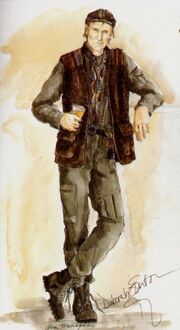
An initial costume sketch for Cochrane
Of all the costumes in First Contact , Costume Designer Deborah Everton felt she was given the most freedom to design Cochrane's clothing. " Even though he's so established in the lore of Star Trek , he's not a character with which we're really familiar, " she mused. " I could really go to town on him and take his character pretty far out. " ( Star Trek: Communicator issue 109 , p. 52) Given that Cochrane had been written as an eccentric genius famed for being a pivotal figure in Human history, Everton wanted to represent the character's kookiness in his costuming, without making him too repulsive to the film's audience. " I wanted to bring out a lovable, quirky quality about him, " she noted. ( The Making of Star Trek: First Contact , p. 80) Cochrane's clothing ended up as a reflection of his personality, a mix of practicality and flamboyance, and encompassed a large sheepskin coat for outdoor scenes. One alternative costume layout for the character was designed by Everton, illustrated in a concept sketch, but not used. Yet another sketch of Cochrane demonstrated a blue-colored spacesuit , worn, in the movie, by not only him but also Riker and La Forge. ( Star Trek: The Magazine Volume 1, Issue 13 , pp. 68 & 69)
The inclusion of a distinctive-looking hat was at the request of Rick Berman, after Deborah Everton had incorporated the headgear in her original sketch for Cochrane's costume. ( The Making of Star Trek: First Contact , p. 81) Further sketches focusing just on the cap were carefully completed, but the headpiece eventually received more decoration around its rim. The cap, featuring more decorative studs around the outer edge, was also illustrated in the sketch of Cochrane wearing a spacesuit. ( Star Trek: The Magazine Volume 1, Issue 13 , p. 69) Everton reflected, " Rick Berman kept liking this hat – every time he would see it on one of the illustrations, it was 'God, I really like that hat!' So when I made it for Cochrane, I wanted to make it sort of funkier, as a character thing. " ( The Making of Star Trek: First Contact , p. 81)
James Cromwell was grateful that Cochrane's costumes included a heavy wool coat that he was able to wear while filming on location in frosty cold night conditions. ( Star Trek Monthly issue 22 , p. 34) He was especially pleased that the costuming did not cover him up as much as he had been, by prosthetics, in his previous Star Trek roles, later remarking, " It was really nice to play someone where you can use what physicality you have and your expressiveness to give him life. When you're in a costume that covers every part of you, that's really a matter of somebody else's imagination dictating what your outer form is. I loved Cochrane's costume because it let me be me, or let me play Cochrane. " ( Starlog issue #234, p. 41) Jonathan Frakes was also pleased with the clothes Cochrane wears in the film, characterizing them as "great costumes." ( audio commentary , Star Trek: First Contact Special Edition / Blu-ray )
On the other hand, the costuming for Cochrane proved baffling to others. For example, Brannon Braga once admitted, " I always meant to ask Deborah Everton, 'What was that hat that he was wearing?' " ( audio commentary , Star Trek: First Contact Special Edition / Blu-ray ) Cochrane's neck-scarf likewise puzzled Damon Lindelof and Anthony Pascale, though the latter hypothesized that Cochrane wearing it might be an attempt to hide a scar . ( audio commentary , Star Trek: First Contact 2009 DVD / Blu-ray )
Second portrayal [ ]
James Cromwell purposely did not watch Glenn Corbett's presentment of Cochrane prior to playing the character himself. " I didn't feel as if I were dealing with a historical character, " Cromwell expressed. " I suppose that I am to some degree, at least in the eyes of some Trekkies , because Corbett played the role before I did. I just felt that what I wanted to do was to give my interpretation of what the writers of First Contact wrote as a character. I didn't need or want any outside assistance as to what somebody else had done with the same fellow. " ( Starlog issue #234, p. 40)
James Cromwell found it easy to appear in the movie role. " They just let me play it as it was written, " he said. " And I looked at him as just me . A guy who is overwhelmed, horny, fun-loving and self-deprecating, which is me. " With a laugh, Cromwell added, " Except that he happens to be an alcoholic. " ( Star Trek: Communicator issue 111 , p. 70) Cromwell also characterized the somewhat "maverick" Cromwell as "a throwback to the 1960s" and "actually the guy who starts Star Trek ." ( The Making of Star Trek: First Contact ) The actor related, " The character came alive for me. Instead of having to play a legend, what I had to play was someone who was reluctant to become a legend. That's immanently playable. It's very hard to play a legend, but it's not so hard to play when you have an action. He had a very strong action, which was that it frightened, confused, confounded and disturbed him. " ( Star Trek Monthly issue 22 , p. 33)
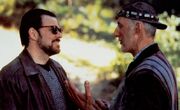
James Cromwell, in the guise of Cochrane, while conversing with Jonathan Frakes
Jonathan Frakes postulated that James Cromwell's stability with playing the part added to the characterization, as did him having great physical ease, especially considering his extreme height. " I think it made him... or made the character more Human and more attractive, because of the way Cromwell tackled the part, " Frakes commented. " Instead of playing it with this sort of straitlaced respect, it was played with a wonderful casualness. " ( audio commentary , Star Trek: First Contact Special Edition / Blu-ray )
One particular element of the story in which Cromwell found difficulty with portraying Cochrane is when the character is finally involved in the actual first contact with the Vulcans. Noted the actor, " All I had to do was say, 'It's real, it's real, it's real.' And I kept on saying to myself, 'What would it look like? What would I do? Would I perspire? Would I shake?' and I thought, 'God, the real thing is that you don't know what you'll do when it actually happens.' " ( The Making of Star Trek: First Contact , p. 110)
Even though Cochrane was instrumental in the construction of the Phoenix , James Cromwell never saw the missile that, in the movie, supposedly delivers the prototype warp ship into space. ( Star Trek Monthly issue 22 , pp. 33-34)
Ultimately, Jonathan Frakes deemed James Cromwell as having been "brilliant in this role." ( audio commentary , Star Trek: First Contact Special Edition / Blu-ray ) Patrick Stewart concurred that Cromwell was "perfect" as Cochrane. ( Fade In: The Writing of Star Trek: Insurrection ) Ronald D. Moore likewise concluded that Cochrane's transformation into "a really cool character," slightly identifiable to the audience, was "once we married [the metamorphosis which the character is implied as going through, during the course of the film] [...] with James Cromwell." ( Cinefantastique , Vol. 28, No. 6, p. 21)
Later references and appearances [ ]
In the first draft script of DS9 : " Rejoined ", Jadzia Dax referenced Zefram Cochrane, excitedly remarking that an experimental technique to create artificial wormholes "could be the most important advance in space travel since Zefram Cochrane invented the warp drive."
Cochrane was additionally mentioned in the series bible for Star Trek: Enterprise . That document noted that he was idolized by Jonathan Archer. [4] (X)
The only physical description of Cochrane in the final revised draft script for the pilot episode of Enterprise , " Broken Bow ", was the word "elderly." [5] In that episode, Cochrane was once again played by James Cromwell. As he had become a relatively big movie star by then, Star Trek 's production personnel had to pull in a favor for him to reprise the role. This task was facilitated by Junie Lowry-Johnson , a big fan of Cromwell's who helped cast both First Contact and "Broken Bow". Rick Berman said of Cromwell's return as Cochrane, " It was interesting to get [him] [....] He was very gracious and did it. " ("Broken Bow" audio commentary , ENT Season 1 DVD special features) Elaborated Berman, " We just needed him for a day [...] and he was sweet enough to come and do it for us in our pilot. " ("The Legacy of Zefram Cochrane" documentary featurette, Star Trek: First Contact Special Edition / Blu-ray ) Cochrane's scene in "Broken Bow" was scheduled to be filmed on 20 June 2001 , on Paramount Stage 16 , but actually ended up being shot there two days later, on 22 June . That morning, Cromwell reported to the makeup department at 7:30 a.m. Makeup and hair-styling were applied to give him an old-age look. He was due on set at 10:30 a.m., though he actually arrived on set sometime between 10:15 and 10:30 a.m. He had no meals during his visit to Paramount and was dismissed from the set at 11:30 a.m. Removal of his makeup then took fifteen minutes. ( "Broken Bow" shooting schedule, call sheets & production reports ) The suit that Cromwell wore to appear as Cochrane in "Broken Bow" was ultimately sold in the It's A Wrap! sale and auction . [6]
In the final draft script of ENT Season 2 outing " First Flight ", Cochrane was referred to in a scene description, in connection with a similarity between the cockpits of the Phoenix and NX-Alpha .
At one stage, Rick Berman was noncommittal about continuing to feature Zefram Cochrane's history in Enterprise , addressing such details as his involvement in the Warp 5 project, his association with Henry Archer, and his eventual disappearance. Shortly after Berman finished work on the making of the second season, he said, " We have not ruled out telling more stories that further Cochrane's story, but we also don't have anything planned in the immediate future. " ( Star Trek Monthly issue 106 , p. 18)
Footage of James Cromwell (as Zefram Cochrane greeting the Vulcans) was reused, with Cromwell's consent, at the beginning of " In a Mirror, Darkly ". ("In a Mirror, Darkly" audio commentary , ENT Season 4 DVD special features) While the final draft script for that episode made it clear the footage was to be reused (dictating Cochrane's physical appearance), the teleplay didn't make any outright statement that the version of Cochrane seen in that episode was actually from the mirror universe .
Age and physical appearance [ ]
↑ According to "Metamorphosis", Cochrane was eighty-seven years old when he arrived on Gamma Canaris N , 150 years before 2267 , suggesting he was born in the year 2030 and disappeared in 2117 . A library computer file in " In a Mirror, Darkly, Part II " uses these years, and this correlates with information provided in the Star Trek Chronology (2nd ed., p. 26) and the Star Trek Encyclopedia (3rd ed., p. 80). However, according to the recording of the dedication of the Warp Five Complex in " Broken Bow ", Cochrane was still on Earth in 2119 , establishing that the "hundred and fifty years" proposed in "Metamorphosis" was not given as an exact figure and making his earliest possible year of birth 2032 . ( Star Trek Encyclopedia (4th ed., vol. 1, p. 149)) According to Star Trek: Star Charts (p. 61), Zefram Cochrane left Earth in 2120 , suggesting a year of birth in 2033 .
The first draft script of Star Trek: First Contact , set in 2063, described Cochrane as "a man in his mid-forties." [7] However, James Cromwell was fifty-six years old during the production of the film, the final version of which is also set in 2063, meaning that the character is supposedly in his early thirties during the events of the film. The Star Trek Encyclopedia (3rd ed., p. 81) accounted for this discrepancy by speculating that Cochrane's aged appearance in the movie was the result of radiation poisoning.
Theories [ ]
At one stage, Star Trek writer and science consultant André Bormanis supposed that Cochrane may have discovered a source of dilithium crystals deep in the Earth's crust and might have invented the formula for verterium cortenide from which the Phoenix 's warp coils were then fashioned. ( Star Trek: The Magazine Volume 2, Issue 7 , pp. 43 & 44) In contrast, according to the earlier Star Fleet Medical Reference Manual (p. 17), dilithium was first discovered in 2049 , from the fifth moon of Jupiter .
Brannon Braga once speculated that Cochrane "probably is instrumental in the formation of Starfleet." ("The Legacy of Zefram Cochrane" documentary featurette, Star Trek: First Contact Special Edition / Blu-ray )
James Cromwell has theorized that, prior to the first flight of the Phoenix , Cochrane had not planned to take the prototype warp craft into space himself, being merely a scientist and having never flown in space before. Proposing that the version of events demonstrated in First Contact constitute an alternate timeline , Cromwell went on to say, " Obviously, he does take it up himself, so something was supposed to happen, and in reality he would have made the choice anyway. Since they [the Enterprise -E crew] come back a little earlier than he had made that choice, he is frightened. " ( Cinefantastique , Vol. 28, No. 6, pp. 29-30)
Likewise, in an audio commentary for First Contact available on the film's Blu-ray and 2009 DVD releases, Anthony Pascale supposed that, prior to encountering the Enterprise -E crew, Cochrane "must have read a journal about time travel in Scientific American , maybe before the Third World War, or something."
In " The Big Goodbye ", an illustration of Zefram Cochrane can be seen when Data is assimilating the Dixon Hill novels. This illustration was from the FASA RPG module The Federation .
Cochrane's first name was consistently spelled "Zephram" in the first draft script of Star Trek: First Contact as well as the call sheets from the production of " Broken Bow ", and the final draft scripts of ENT : " Carbon Creek ", " Singularity ", " Future Tense ", and " Horizon ". [8] [9] Similarly, in the film's credits, the character's surname is misspelled "Cochran". The final draft scripts of ENT : " Regeneration " and " Anomaly (ENT) " spelled the character's full name "Zefram Cochrane".
Cochrane was mentioned in a scene deleted from Star Trek Nemesis , in which Picard quoted Cochrane as having said, " To seek out new life and new civilizations. "
Cochrane is the only character to utter the phrase "star trek" in the franchise, which he does in First Contact , although Q does use the phrase " trek through the stars " in the Star Trek: The Next Generation series finale, " All Good Things... ". The prospect of somehow working the phrase "star trek" into the franchise had been a secret fantasy of Rick Berman's for about the past eight years, but had proven challenging to carry out due to the oddness of the phrase. Brannon Braga offered, " We went round and round about that, [contemplating] whether it should just be 'trek,' 'star journey' [or something else]. " ( audio commentary , Star Trek: First Contact Special Edition / Blu-ray ) James Cromwell was conscious of whether the line sounded like a natural or intentional reference, stating, " Hopefully it came out [...] as, you know, searching for an idea. " Cromwell believed that Cochrane saying the line while in a forested area helped make the reference sound natural, interesting, and somewhat fitting. ("The Legacy of Zefram Cochrane" documentary featurette, Star Trek: First Contact Special Edition / Blu-ray ) However, audience response to the line, when the film was exhibited in movie theaters, was not only sometimes laughter but also occasionally groans. ( audio commentary , Star Trek: First Contact Special Edition / Blu-ray )
The first season South Park episode "Damien" references a line spoken by Cochrane in First Contact : " Don't try to be a great man, just be a man. " ( AOL chat , 1998 )
Apocrypha [ ]
In the novelization of "Metamorphosis" (as adapted by James Blish in Star Trek 7 ), Cochrane made mention of having been on Vulcan and professed, " I was always pretty much of a loner. Spent years in space by myself. " After Spock outlined that he had concluded the Companion's homeworld was once a moon of some now-destroyed larger celestial body and was colonized by a highly advanced civilization, Cochrane agreed and attested that he had found some artifacts that corroborated these theories.
In the novelization of Star Trek: First Contact , it was suggested that Cochrane's alcoholism was not his only issue. He also suffered from bipolar disorder , a condition that had been treated with a cerebral implant that delivered the necessary medications. After World War III, however, Cochrane was unable to find either a way to refill the implant, nor a suitable replacement, so he took to self-medicating with alcohol. The crew of the Enterprise -E was able to stabilize his condition enough for him to complete his work on the Phoenix , and Beverly Crusher cured the disorder permanently, shortly before returning to the Enterprise . In addition, this novelization specified that Cochrane was born in the year 2013 , as opposed to 2030 or 2032 , which would be more consistent with actor James Cromwell's real-life age and countenance in the film.
The reasoning for Cochrane having a far more weathered and older appearance than his natural age had often been given in non- canon literature (most notably the Pocket Books novel Federation ) as being a result of him suffering from radiation poisoning. In the comics story " A Warp in Space " (printed as the forty-ninth issue of Gold Key TOS ), Cochrane was shown as an elderly-looking man, even in flashback events from "Metamorphosis", with no explanation given for the change in his appearance.
The novel First Frontier divulged that Cochrane accidentally stumbled on the secrets of the warp drive and that he had originally been looking for something else, though it was never indicated what he had been looking for, exactly.
A lot of the Star Trek literature of the 1980s describes Cochrane as a native of Alpha Centauri, which is inhabited by Preserver-transplanted Humans. The novel Memory Prime explains that "Zefram Cochrane" is an anglicized version of his true name: "Zeyafram Co'akran". FASA 's RPG sourcebook The Federation gives his full name as "Zephram Edark Cochrane" and claims he was born in Lurivala, Alpha Centauri.

Cochrane and Lily witnessing the Autobots leaving Earth
Cochrane appeared via flashback in the second issue of the comic crossover mini-series Star Trek vs. Transformers where he and Lily Sloane are shown witnessing the Autobots leaving Earth aboard the Titan Fortress Maximus during the beginning of World War III.
In the reference book Star Trek: Federation - The First 150 Years , Cochrane grew up with a love for science, as his parents, Jesse and Hilde Cochrane, were academics. He had a rough adolescence because of the fallout from various wars and conflicts and learned to internalize his love of science. As interest in science went down around the country, Cochrane got a job with a military contractor, at one of the last places with an active science lab. There, he began designing antimatter weapons , as he was fascinated with matter/antimatter reactions and it was the only way to access the latest research.
External links [ ]
- Zefram Cochrane at Memory Beta , the wiki for licensed Star Trek works
- Dr. Zefram Cochrane at StarTrek.com
- Zefram Cochrane at Wikipedia
- 1 Rachel Garrett
- 3 USS Enterprise (NCC-1701-G)
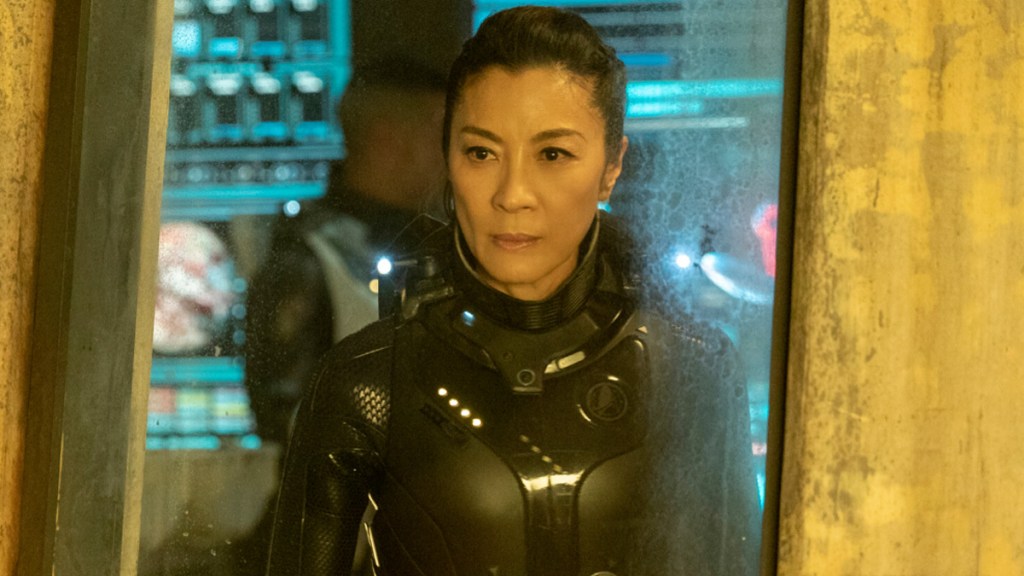
Star Trek: Section 31 First Look Image Released
By Lee Freitag
Paramount+ has shared a first look at the upcoming Star Trek: Section 31 starring Michelle Yeoh .
The image, released as part of Variety ‘s in-depth profile on the future of the Star Trek franchise, shows the Mirror Universe’s Philippa Georgiou whispering into an undisclosed character’s ear. Yeoh is returning to the role of Georgiou for Section 31 after previously playing the character across the first three seasons of the Paramount+ series Star Trek: Discovery .
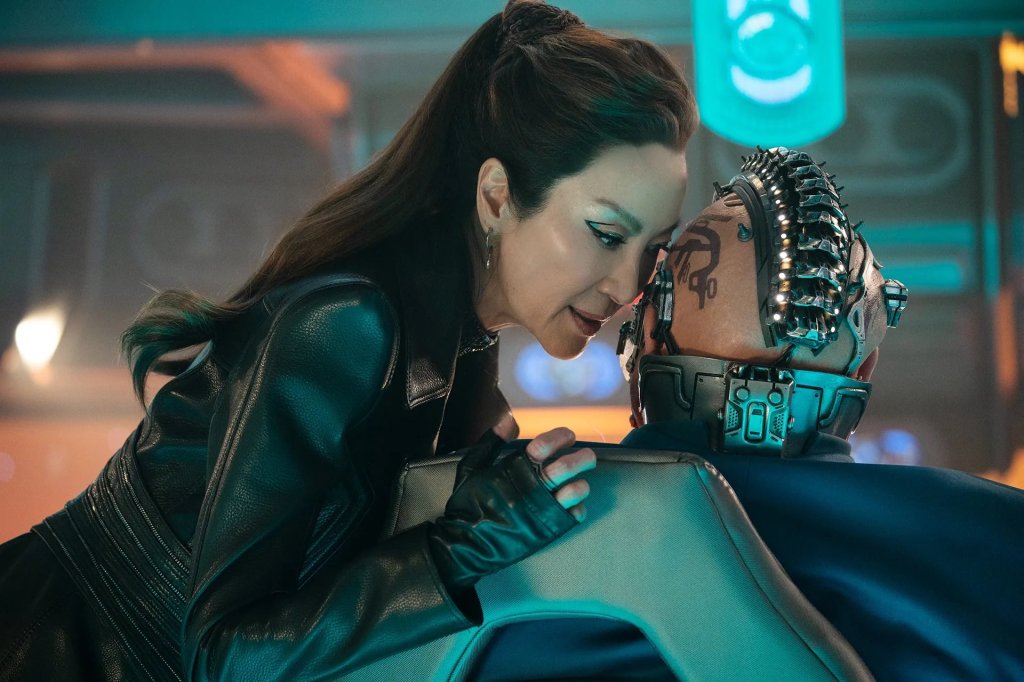
Section 31 was almost a television series
Star Trek: Section 31 was initially announced in January 2019 as a Discovery spinoff series focusing on Section 31, with Alex Kurtzman attached as an executive producer and Bo Yeon Kim and Erika Lippoldt on board as showrunners. However, after four years in development, Paramount+ announced that Section 31 had been redeveloped as a feature-length film to accommodate Yeoh’s busy schedule.
Production on Section 31 took place in Toronto, Canada, from January to March 2024, with Olatunde Osunsanmi directing from a screenplay written by Craig Sweeny. While plot details remain under wraps, Sweeney shared with Variety that the movie will “deliver an entertaining experience that is true to the universe but appeals to newcomers,” explaining that he “wanted a low barrier of entry so that anybody could enjoy it.”
Unlike most Star Trek projects, Kurtzman revealed that Section 31 will focus on those “who don’t quite fit in,” allowing for the movie to explore “the people who were at the edges, out in the field. These are not people who necessarily work together the way you would see on a Star Trek bridge.”
Who else stars in Section 31?
Besides Yeoh, the cast for Star Trek: Section 31 includes Omari Hardwick, Sam Richardson, Sven Ruygrok, Robert Kazinsky, Humberly Gonzalez, and James Hiroyuki Liao. Kacey Rohl has also joined the project as a young Rachel Garrett, the future captain of the USS Enterprise-C. An older version of the character previously appeared on Star Trek: The Next Generation, portrayed by Tricia O’Neil.
Star Trek: Section 31 has not yet received a release date, but will stream exclusively on Paramount+.
Lee Freitag has been fascinated with the movie and TV industry since a young age. When he's not covering the latest superhero news, Lee can be found trying to convince his friends that Avengers: Age of Ultron is the best Avengers movie.
Share article
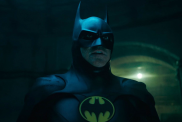
Batman: Michael Keaton Recalls Jack Nicholson’s Comments About Batsuit Workout Training
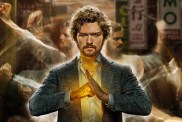
Iron Fist: Finn Jones Hints at MCU Return
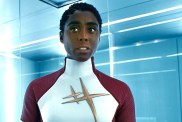
The Marvels: Lashana Lynch Addresses Binary’s MCU Future
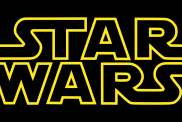
Star Wars: Game of Thrones Showrunners Talk Scrapped Trilogy Plans
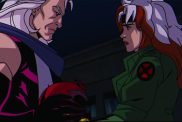
Why Rogue and Magneto’s Relationship in X-Men ‘97 Is Fake
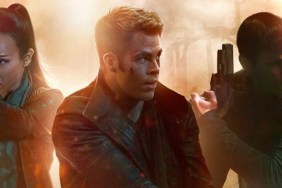
Star Trek 4 Lands New Writer With HBO’s The Flight Attendant Creator
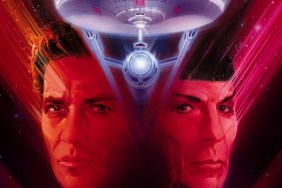
William Shatner Talks Star Trek V: The Final Frontier Regrets
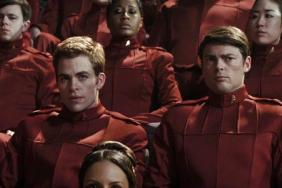
Starfleet Academy: Filming Window Revealed for New Star Trek Series
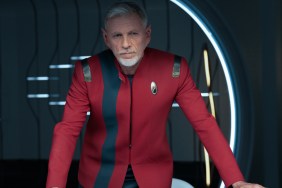
Star Trek Discovery Season 5 Eps 1-4 Review: Waltz of Jellico

James Cromwell's 4 Star Trek Roles Explained
- James Cromwell's versatile acting career included four different characters in the Star Trek universe.
- Each of Cromwell's Star Trek appearances involved unique alien roles in different series.
- Cromwell's portrayal of Dr. Zefram Cochrane in Star Trek: First Contact marked a significant role in Federation history.
Emmy award winner and Academy Award nominee James Cromwell has appeared as four different characters in the Star Trek universe. A prolific character actor, Cromwell began acting in 1974 with an appearance on The Rockford Files . From there, he went on to appear in numerous popular television shows throughout the 1970s, including All in the Family, M*A*S*H, Three's Company, and Diff'rent Strokes. He continued appearing on television in the 1980s, in episodes of Little House on the Prarie and Barney Miller , among many others, but also began taking on film roles. His first starring role came in the 1992 film Babe , for which Cromwell was nominated for an Academy Award.
Although James Cromwell is likely most recognizable to Star Trek fans as Zefram Cochrane from Star Trek: First Contact , the actor had played three other Trek characters before appearing in that film. Cromwell's Star Trek debut came in Star Trek: The Next Generation season 3, episode 11, "The Hunted," in which he portrayed the bureaucratic Prime Minister of the Angosians. Cromwell later appeared in one of TNG's two-part episodes , season 6's "Birthright" as a Yridian dealer named Jaglom Shrek. In Star Trek: Deep Space Nine season 4, episode 7, "Starship Down," Cromwell took on another alien role, a Karemma named Hanok who serves as a commerce minister.
Every Star Trek Movie Ranked (From Worst To Best)
Star trek: the next generation season 3, episode 11 - "the hunted", star trek: the next generation.
Cast Michael Dorn, LeVar Burton, Brent Spiner, Wil Wheaton, Jonathan Frakes, Patrick Stewart, Marina Sirtis, Gates McFadden
Franchise(s)
Showrunner Jeri Taylor, Michael Piller, Rick Berman
Where To Watch Paramount+
Streaming Service(s) Paramount+
Writers Jeri Taylor, Michael Piller, Rick Berman, Brannon Braga, Ronald D. Moore
In Star Trek: The Next Generation 's "The Hunted," Captain Jean-Luc Picard (Patrick Stewart) and the USS Enterprise-D visit the planet of Angosia III to assess their petition to join the United Federation of Planets . As the Prime Minister, James Cromwell's Nayrok is the first person to approach Picard, and he requests help to apprehend a dangerous escaped convict. The Enterprise soon finds the prisoner, whose name is Roga Danar (Jeff McCarthy), but his story does not quite match up with that of Nayrok. According to Danar, he and many of his fellow prisoners were genetically enhanced soldiers who fought a war for the Angosians.
After the Angosian wars ended, the enhanced soldiers had difficulty reintegrating into civilian life, and they were banished to a penal colony. When Picard confronts Nayrok about Danar's claims, Nayrok refuses to answer, claiming it to be a matter of internal security. When Danar leads the inmates in a rebellion against the government building, Nayrok asks Captain Picard for help. Picard, however, states that the conflict seems like an internal matter that Nayrok must handle himself. Due to the human rights violations Nayrok and the Angosian government committed against their soldiers and veterans, Angosia III's application to join the Federation is denied.
The story of Damar and the Angosian government's treatment of veterans was meant as an allegory to US veterans of the Vietnam War. While the end result is arguably effective, it's not exactly subtle.
Jaglom Shrek
Star trek: the next generation season 6, episodes 16 & 17 - "birthright, parts 1 & 2".
In Star Trek: The Next Generation's "Birthright" two-parter, the Starship Enterprise visits space station Deep Space Nine, and James Cromwell's Jaglom Shrek kicks off the main plot involving Lt. Worf (Michael Dorn). A member of the Yridian species, Shrek is an information broker who tells Worf that his father Mogh may have survived the Khitomer Massacre. Shrek claims that Mogh is alive in a Romulan prison camp, but Worf doubts this information and makes the Yridian personally take him to the camp. Once there, Worf learns that his father did die at Khitomer as he believed and his family's honor remains intact.
The Romulan guards prevent Worf from leaving since he now knows the location of the camp. Worf inspires some of the young Klingons to be curious about their culture and heritage, and the Romulans eventually allow them to leave the prison camp. Jaglom Shrek only appears briefly in "Birthright, Part II" and has no lines, but his role was originally meant to be bigger. James Cromwell broke his leg in between filming the two parts of the episode, which resulted in his role being reduced. In the initial script, Worf learned more about Shrek's past, and he became a more sympathetic character.
Star Trek: Deep Space Nine Season 4, Episode 7 - "Starship Down"
Star trek: deep space nine.
Cast Terry Farrell, Cirroc Lofton, Rene Auberjonois, Nicole de Boer, Michael Dorn, Andrew Robinson, Nana Visitor, Avery Brooks, Colm Meaney, Armin Shimerman, Alexander Siddig
Streaming Service(s)
Showrunner Ira Steven Behr, Michael Piller
Writers Ira Steven Behr, Michael Piller, Ronald D. Moore
"Starship Down" follows the senior staff from Deep Space Nine as they meet with James Cromwell's Hanok for secret trade agreements. Hanok represents the interests of the Karemma, who live on a planet in the Gamma Quadrant and are part of the Dominion. As Hanok meets with Captain Benjamin Sisko (Avery Brooks) and DS9's crew, two Jem'Hadar ships emerge and fire on the Karemma ship. When the Defiant enters the fray, the ship is severely damaged.
Hanok ends up trapped in the Defiant's mess hall with Ferengi bartender Quark (Armin Shimerman) , who was acting as a mediator for the negotiations. As Quark has been imposing fake Federation tariffs, Hanok is reluctant to trust the Ferengi. When a torpedo impacts the mess hall without detonating, Quark and Hanok must work together to defuse it, which helps Hanok gain respect for Quark. After the Defiant makes it safely back to DS9, Quark shows Hanok how to play Dabo, and the Karemma wins a significant amount of money.
Best Star Trek: DS9 Episode From Each Of The Shows 7 Seasons
Zefram cochrane, star trek: first contact.
In his most substantial Star Trek role, James Cromwell portrays Dr. Zefram Cochrane in Star Trek: First Contact . As the inventor of warp drive technology, Cochrane holds a special place in Federation history as his invention led to Earth's first contact with the Vulcans. The character of Zefram Cochrane (played by Glenn Corbett) was first mentioned in Star Trek: The Original Series season 2, episode 9, "Metamorphosis," when the Starship Enterprise found him marooned on an asteroid. A mysterious entity known as the Companion (Elinor Donahue) had restored Cochrane's youth and kept him alive for 150 years.
In First Contact , Captain Picard and the USS Enterprise-E follow a Borg cube back in time to 2063 Earth, where the Borg are trying to prevent human's first contact with aliens. The Enterprise destroys the Borg ship, and then several members of the crew beam down to ensure Cochrane's historic flight happens as it was meant to. Lt. Commander Geordi La Forge (LeVar Burton) and Lt. Reginald Barclay (Dwight Schultz), in particular, are excited to meet one of their heroes and are somewhat disappointed to learn that Cochrane's true motivations were financial.
James Cromwell also provided the voice for a hologram of Zefram Cochrane in Star Trek: Lower Decks season 3, episode 1, "Grounded," which reveals that the site of first contact has become an amusement park.
After the damage caused by the Borg, Cochrane initially wants to abandon his plans, but Commander William Riker (Jonathan Frakes) and the Enterprise crew convince him to continue. In the end, Cochrane, Riker, and La Forge board the ship called the Phoenix and break the warp barrier. Not long after, a Vulcan survey ship called the T'Plana-Hath lands in Bozeman, Montana to greet humans for the first time, as the Enterprise crew watches from a distance. Picard and his friends then return to the 24th century, having ensured that the seeds of the Federation and Star Trek's future were planted.
Star Trek: The Next Generation & Star Trek: Deep Space Nine are streaming on Paramount+.
Star Trek: First Contact is streaming on Max.
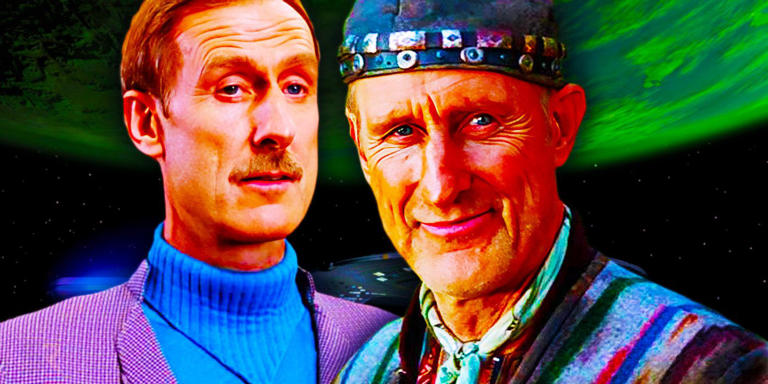

If you noticed a beaming string of light in the Arizona sky on Monday evening, you caught a glimpse of SpaceX's Falcon 9 rocket launch from California's Vandenberg Space Force Base.
SpaceX planned to launch another batch of its Starlink internet satellites to orbit Monday night. Star gazers in both the Phoenix and Tucson areas reported seeing the rocket on X, formerly known as Twitter.
X users were able to watch the action live via SpaceX's account on X.
Falcon 9 successfully landed vertically on the droneship "Of Course I Still Love You," which was stationed in the Pacific Ocean, less than 10 minutes after the launch. It was the 10th launch and landing for this particular booster, according to a SpaceX mission description .
The Falcon 9's upper stage was expected to continue hauling the 22 Starlink satellites to low Earth orbit. The satellites were expected to be deployed there about an hour after liftoff.
SpaceX rocket also carried satellites into orbit in Friday's launch
After two days of delays , the SpaceX Falcon 9 rocket was finally able to launch Friday to deploy Starlink satellites into orbit.
The launch took place at NASA's Kennedy Space Center in Cape Canaveral, located about 100 miles from the Mets’ spring training facility in Florida.
Falcon 9 , a reusable, two-stage rocket, has become integral to a variety of SpaceX. In February, the rocket helped launch an uncrewed lunar lander into orbit that eventually become the first privately-built craft to ever make it to the moon .

COMMENTS
A method of returning the Phoenix to Earth intact is illustrated by the artist in Star Trek: The Art of John Eaves. Eaves depicts a flight pattern chart that shows the Phoenix landing by way of a feathered reentry configuration and parachutes. Footage of the Phoenix from First Contact was reused in the opening credits for Star Trek: Enterprise.
In Star Trek: First Contact, the Borg nearly succeeded in their mission to prevent First Contact when they damaged the Phoenix the day before it was due to launch. With help from the crew of the Enterprise-E, Cochrane was able to repair the damage and successfully complete mankind's first warp flight. Commander William Riker (Jonathan Frakes ...
Star Trek: First Contact follows Captain Jean-Luc Picard (Patrick Stewart) and the crew of the USS Enterprise-E as they travel back in time to April 2063, to stop a Borg invasion. The Enterprise arrives on Earth just before Zefram Cochrane (James Cromwell) is meant to make the first-ever warp flight in his ship, the Phoenix.
The route of the Phoenix is shown in the Star Trek: Star Charts factbook. The distance travelled appears to be approximately the diameter of Earth's orbit (e.g. 16 light minutes). In the film (and the film's novelisation), the ship travels at lightspeed (Warp 1) for what appears to be several minutes.
Phoenix was never shown landing. However, John Eaves, Chief concept artist for Star Trek's many series, In his art book it depicts a flight pattern chart that shows the Phoenix landing by way of a feathered reentry configuration and parachutes so it returned to Earth much like a space capsule. Share. Improve this answer.
Of course, the Phoenix seen in 'First Contact' went straight to the TOS-type nacelles, so that short-circuited any slower developmental hardware steps." Star Trek Chronology (1st & 2nd edition) The first Star Trek Chronology appeared in 1993 as an officially approved timeline of the Star Trek Universe with a comparably small amount of speculation.
From composer Joel Goldsmith, this piece was not included in the original motion picture soundtrack when first released. This piece was played during the fin...
Zephram Cochrane's (James Cromwell) starship, the Phoenix, is a great Star Trek starship retcon. The Phoenix was introduced in Star Trek: First Contact as the experimental starship Cochrane built after the end of World War III.On April 5, 2063, Dr. Cochrane achieved Mankind's first successful warp flight, which caught the attention of nearby Vulcans.
The first, and only, flight of the Phoenix took place on 5 April 2063. It was launched from Montana and was crewed by Cochrane, William T. Riker and Geordi La Forge. The ship's flight attracted the attention of a passing Vulcan ship, the T'Plana-Hath, leading to first contact between Humans and Vulcans. ( TNG movie: First Contact )
Prior to his warp flight Cochrane was in fact a cynic and habitual drunk who created the Phoenix in order to generate a personal fortune. When told about his role in the future Cochrane attempted to back out of the flight, but was coerced into taking part by Enterprise personnel. The Phoenix launched on schedule on the morning of April 5th 2063.
First Contact Day pays tribute to the flight of the warp-capable Phoenix and the pivotal first interaction between humans and Vulcans, which occurred on April 5, 2063. The Phoenix, built and piloted by inventor Zefram Cochrane, was the spacecraft that marked mankind's first successful attempt at traveling at warp, utilizing a warp drive.
Fun Fact: all those bystanders (only a hundred meters or so from the former Nuclear Triad silo) would have been killed by the sound energy released by the Mi...
The first warp flight of the Phoenix as depicted in Star Trek First Contact. I edited the clip to give it an animated feel and added Steppenwolf's Magic Carp...
The Fate of the Phoenix is a Bantam TOS novel, written by Sondra Marshak and Myrna Culbreath. First published in May 1979, the novel is a sequel to the 1977 book The Price of the Phoenix. From the book jacket With the Romulans approaching the boundaries of Federation space and the Klingons threatening to break the Organian peace treaty, Captain Kirk and his crew face a new peril in the person ...
The Flight of the Phoenix: Directed by Robert Aldrich. With James Stewart, Richard Attenborough, Peter Finch, Hardy Krüger. After an oil company plane crashes in the Sahara, the survivors are buoyed with hope by one of the passengers, an airplane designer who plans for them to build a flyable plane from the wreckage.
First Contact Day was a holiday celebrated to honor both the warp 1 flight of the Phoenix and first open contact between Humans and Vulcans on April 5th, 2063 in Bozeman, Montana. (Star Trek: First Contact) The mirror universe equivalent of First Contact Day was also on April 5th. Instead of peacefully greeting the Vulcans, the Terrans slaughtered all of the members of the survey ship. The day ...
Star Trek: Phoenix is a Star Trek fan-created anthology series produced and filmed by Temporal Studios. The series was created by Leo Roberts and later developed by Leo Roberts, Jön Johnson and Star Trek author, Jeff Ayers. The story is set 42 years after Star Trek: Nemesis in the prime universe created by Gene Roddenberry and follows the crew of the Federation's first political flagship, the ...
The Flight of the phoenix is a grim, tenseful, realistic tale of a small group of men forced down on the North African desert and their desperate efforts to build a single-engine plane out of the ...
Episodes - Season 1. Stardate: 2270.07.10. Game Date: 04 Oct 13. Episode 7: A Howl in the Dark. En route back to deep space, the Phoenix picks up a distress call and are surprised it is of Klingon origin. Following the call to its source brings the Phoenix to an unexplored M class planet, NGC-2647B, not far from Romulan space.
After watching "Star Trek: First Contact" I wanted (ofcourse) to hear full version of "Magic Carpet Ride"...best watching the flight of Phoenix with it. Afte...
"Phoinix" is the Greek spelling of "Phoenix." Issue 1. Flight of the Phoinix v.1 n.1 was published in January 1976 and contains 31 pages. A second printing was issued in March 1976. ... The Future of Star Trekkin', article by Sylvia Hunt ("Star Trek will never die because its spirit is undying. Sylvia Hung takes a look at what makes Star Trek ...
Flight of the Phoenix: Directed by John Moore. With Dennis Quaid, Tyrese Gibson, Giovanni Ribisi, Miranda Otto. Survivors of a plane crash in the Mongolian desert work together to build a new plane.
Dr. Zefram Cochrane was a Human scientist in the 21st century and a pivotal figure in Human history. An eccentric genius, he was the inventor of warp drive on Earth and became the first recorded Human to travel faster than light, prompting official first contact with the Vulcans. (Star Trek: First Contact; ENT: "Broken Bow", "Future Tense", "Home"; TOS: "Metamorphosis"; TNG: "New Ground"; VOY ...
Star Trek: Section 31 was initially announced in January 2019 as a Discovery spinoff series focusing on Section 31, with Alex Kurtzman attached as an executive producer and Bo Yeon Kim and Erika ...
In Star Trek: The Next Generation's "Birthright" two-parter, the Starship Enterprise visits space station Deep Space Nine, and James Cromwell's Jaglom Shrek kicks off the main plot involving Lt ...
Steve Yockey, creator of the Max series "The Flight Attendant," is joining Starfleet as the new screenwriter for "Star Trek 4." Story details remain under a powerful cloaking device, but Paramount Pictures and Bad Robot still intend the project to be the final chapter for the cast that rebooted the franchise in movie theaters with 2009's "Star Trek," including Chris Pine (as Capt ...
Star gazers in both the Phoenix and Tucson areas reported seeing the rocket on X, formerly known as Twitter. X users were able to watch the action live via SpaceX's account on X.